4776e6bc28a16bcc14d8324c63b263d7.ppt
- Количество слайдов: 150
 PART A Ordinary Differential Equations (ODEs) Part A p 1 Advanced Engineering Mathematics, 10/e by Edwin Kreyszig Copyright 2011 by John Wiley & Sons. All rights reserved.
PART A Ordinary Differential Equations (ODEs) Part A p 1 Advanced Engineering Mathematics, 10/e by Edwin Kreyszig Copyright 2011 by John Wiley & Sons. All rights reserved.
 CHAPTER 2 Second-Order Linear ODEs Chapter 2 p 2 Advanced Engineering Mathematics, 10/e by Edwin Kreyszig Copyright 2011 by John Wiley & Sons. All rights reserved.
CHAPTER 2 Second-Order Linear ODEs Chapter 2 p 2 Advanced Engineering Mathematics, 10/e by Edwin Kreyszig Copyright 2011 by John Wiley & Sons. All rights reserved.
 2. 1 Section 2. 1 p 3 Homogeneous Linear ODEs of Second Order Advanced Engineering Mathematics, 10/e by Edwin Kreyszig Copyright 2011 by John Wiley & Sons. All rights reserved.
2. 1 Section 2. 1 p 3 Homogeneous Linear ODEs of Second Order Advanced Engineering Mathematics, 10/e by Edwin Kreyszig Copyright 2011 by John Wiley & Sons. All rights reserved.
 2. 1 Homogeneous Linear ODEs of Second Order A second-order ODE is called linear if it can be written (1) y” + p(x)y’ + q(x)y = r(x) and nonlinear if it cannot be written in this form. Section 2. 1 p 4 Advanced Engineering Mathematics, 10/e by Edwin Kreyszig Copyright 2011 by John Wiley & Sons. All rights reserved.
2. 1 Homogeneous Linear ODEs of Second Order A second-order ODE is called linear if it can be written (1) y” + p(x)y’ + q(x)y = r(x) and nonlinear if it cannot be written in this form. Section 2. 1 p 4 Advanced Engineering Mathematics, 10/e by Edwin Kreyszig Copyright 2011 by John Wiley & Sons. All rights reserved.
 2. 1 Homogeneous Linear ODEs of Second Order If r(x) ≡ 0 (that is, r(x) = 0 for all x considered; read “r(x) is identically zero”), then (1) reduces to (2) y” + p(x)y’ + q(x)y = 0 and is called homogeneous. If r(x) ≡ 0, then (1) is called nonhomogeneous. Section 2. 1 p 5 Advanced Engineering Mathematics, 10/e by Edwin Kreyszig Copyright 2011 by John Wiley & Sons. All rights reserved.
2. 1 Homogeneous Linear ODEs of Second Order If r(x) ≡ 0 (that is, r(x) = 0 for all x considered; read “r(x) is identically zero”), then (1) reduces to (2) y” + p(x)y’ + q(x)y = 0 and is called homogeneous. If r(x) ≡ 0, then (1) is called nonhomogeneous. Section 2. 1 p 5 Advanced Engineering Mathematics, 10/e by Edwin Kreyszig Copyright 2011 by John Wiley & Sons. All rights reserved.
 2. 1 Homogeneous Linear ODEs of Second Order An example of a nonhomogeneous linear ODE is y” + 25 y = e−x cos x, and a homogeneous linear ODE is xy” + y’ + xy = 0, written in standard form Section 2. 1 p 6 Advanced Engineering Mathematics, 10/e by Edwin Kreyszig Copyright 2011 by John Wiley & Sons. All rights reserved.
2. 1 Homogeneous Linear ODEs of Second Order An example of a nonhomogeneous linear ODE is y” + 25 y = e−x cos x, and a homogeneous linear ODE is xy” + y’ + xy = 0, written in standard form Section 2. 1 p 6 Advanced Engineering Mathematics, 10/e by Edwin Kreyszig Copyright 2011 by John Wiley & Sons. All rights reserved.
 2. 1 Homogeneous Linear ODEs of Second Order An example of a nonlinear ODE is y”y + y’ 2 = 0. The functions p and q in (1) and (2) are called the coefficients of the ODEs. Section 2. 1 p 7 Advanced Engineering Mathematics, 10/e by Edwin Kreyszig Copyright 2011 by John Wiley & Sons. All rights reserved.
2. 1 Homogeneous Linear ODEs of Second Order An example of a nonlinear ODE is y”y + y’ 2 = 0. The functions p and q in (1) and (2) are called the coefficients of the ODEs. Section 2. 1 p 7 Advanced Engineering Mathematics, 10/e by Edwin Kreyszig Copyright 2011 by John Wiley & Sons. All rights reserved.
 2. 1 Homogeneous Linear ODEs of Second Order Solutions are defined similarly as for first-order ODEs in Chap. 1. A function y = h(x) is called a solution of a (linear or nonlinear) second-order ODE on some open interval I if h is defined and twice differentiable throughout that interval and is such that the ODE becomes an identity if we replace the unknown y by h, the derivative y’ by h’, and the second derivative y” by h”. Section 2. 1 p 8 Advanced Engineering Mathematics, 10/e by Edwin Kreyszig Copyright 2011 by John Wiley & Sons. All rights reserved.
2. 1 Homogeneous Linear ODEs of Second Order Solutions are defined similarly as for first-order ODEs in Chap. 1. A function y = h(x) is called a solution of a (linear or nonlinear) second-order ODE on some open interval I if h is defined and twice differentiable throughout that interval and is such that the ODE becomes an identity if we replace the unknown y by h, the derivative y’ by h’, and the second derivative y” by h”. Section 2. 1 p 8 Advanced Engineering Mathematics, 10/e by Edwin Kreyszig Copyright 2011 by John Wiley & Sons. All rights reserved.
 2. 1 Homogeneous Linear ODEs of Second Order Homogeneous Linear ODEs: Superposition Principle Linear ODEs have a rich solution structure. For the homogeneous equation the backbone of this structure is the superposition principle or linearity principle, which says that we can obtain further solutions from given ones by adding them or by multiplying them with any constants. Of course, this is a great advantage of homogeneous linear ODEs. Section 2. 1 p 9 Advanced Engineering Mathematics, 10/e by Edwin Kreyszig Copyright 2011 by John Wiley & Sons. All rights reserved.
2. 1 Homogeneous Linear ODEs of Second Order Homogeneous Linear ODEs: Superposition Principle Linear ODEs have a rich solution structure. For the homogeneous equation the backbone of this structure is the superposition principle or linearity principle, which says that we can obtain further solutions from given ones by adding them or by multiplying them with any constants. Of course, this is a great advantage of homogeneous linear ODEs. Section 2. 1 p 9 Advanced Engineering Mathematics, 10/e by Edwin Kreyszig Copyright 2011 by John Wiley & Sons. All rights reserved.
 2. 1 Homogeneous Linear ODEs of Second Order Theorem 1 Fundamental Theorem for the Homogeneous Linear ODE (2) For a homogeneous linear ODE (2), any linear combination of two solutions on an open interval I is again a solution of (2) on I. In particular, for such an equation, sums and constant multiples of solutions are again solutions. Section 2. 1 p 10 Advanced Engineering Mathematics, 10/e by Edwin Kreyszig Copyright 2011 by John Wiley & Sons. All rights reserved.
2. 1 Homogeneous Linear ODEs of Second Order Theorem 1 Fundamental Theorem for the Homogeneous Linear ODE (2) For a homogeneous linear ODE (2), any linear combination of two solutions on an open interval I is again a solution of (2) on I. In particular, for such an equation, sums and constant multiples of solutions are again solutions. Section 2. 1 p 10 Advanced Engineering Mathematics, 10/e by Edwin Kreyszig Copyright 2011 by John Wiley & Sons. All rights reserved.
 2. 1 Homogeneous Linear ODEs of Second Order Initial Value Problem. Basis. General Solution For a second-order homogeneous linear ODE (2) an initial value problem consists of (2) and two initial conditions (4) y(x 0) = K 0, y’(x 0) = K 1. These conditions prescribe given values K 0 and K 1 of the solution and its first derivative (the slope of its curve) at the same given x = x 0 in the open interval considered. Section 2. 1 p 11 Advanced Engineering Mathematics, 10/e by Edwin Kreyszig Copyright 2011 by John Wiley & Sons. All rights reserved.
2. 1 Homogeneous Linear ODEs of Second Order Initial Value Problem. Basis. General Solution For a second-order homogeneous linear ODE (2) an initial value problem consists of (2) and two initial conditions (4) y(x 0) = K 0, y’(x 0) = K 1. These conditions prescribe given values K 0 and K 1 of the solution and its first derivative (the slope of its curve) at the same given x = x 0 in the open interval considered. Section 2. 1 p 11 Advanced Engineering Mathematics, 10/e by Edwin Kreyszig Copyright 2011 by John Wiley & Sons. All rights reserved.
 2. 1 Homogeneous Linear ODEs of Second Order The conditions (4) are used to determine the two arbitrary constants c 1 and c 2 in a general solution (5) y = c 1 y 1 + c 2 y 2 of the ODE; here, y 1 and y 2 are suitable solutions of the ODE. This results in a unique solution, passing through the point (x 0, K 0) with K 1 as the tangent direction (the slope) at that point. That solution is called a particular solution of the ODE (2). Section 2. 1 p 12 Advanced Engineering Mathematics, 10/e by Edwin Kreyszig Copyright 2011 by John Wiley & Sons. All rights reserved.
2. 1 Homogeneous Linear ODEs of Second Order The conditions (4) are used to determine the two arbitrary constants c 1 and c 2 in a general solution (5) y = c 1 y 1 + c 2 y 2 of the ODE; here, y 1 and y 2 are suitable solutions of the ODE. This results in a unique solution, passing through the point (x 0, K 0) with K 1 as the tangent direction (the slope) at that point. That solution is called a particular solution of the ODE (2). Section 2. 1 p 12 Advanced Engineering Mathematics, 10/e by Edwin Kreyszig Copyright 2011 by John Wiley & Sons. All rights reserved.
 2. 1 Homogeneous Linear ODEs of Second Order Definition General Solution, Basis, Particular Solution A general solution of an ODE (2) on an open interval I is a solution (5) in which y 1 and y 2 are solutions of (2) on I that are not proportional, and c 1 and c 2 are arbitrary constants. These y 1, y 2 are called a basis (or a fundamental system) of solutions of (2) on I. A particular solution of (2) on I is obtained if we assign specific values to c 1 and c 2 in (5). Section 2. 1 p 13 Advanced Engineering Mathematics, 10/e by Edwin Kreyszig Copyright 2011 by John Wiley & Sons. All rights reserved.
2. 1 Homogeneous Linear ODEs of Second Order Definition General Solution, Basis, Particular Solution A general solution of an ODE (2) on an open interval I is a solution (5) in which y 1 and y 2 are solutions of (2) on I that are not proportional, and c 1 and c 2 are arbitrary constants. These y 1, y 2 are called a basis (or a fundamental system) of solutions of (2) on I. A particular solution of (2) on I is obtained if we assign specific values to c 1 and c 2 in (5). Section 2. 1 p 13 Advanced Engineering Mathematics, 10/e by Edwin Kreyszig Copyright 2011 by John Wiley & Sons. All rights reserved.
 2. 1 Homogeneous Linear ODEs of Second Order Furthermore, as usual, y 1 and y 2 are called proportional on I if for all x on I, (6) (a) y 1 = ky 2 or (b) y 2 = ly 1 where k and l are numbers, zero or not. (Note that (a) implies (b) if and only if k ≠ 0). Section 2. 1 p 14 Advanced Engineering Mathematics, 10/e by Edwin Kreyszig Copyright 2011 by John Wiley & Sons. All rights reserved.
2. 1 Homogeneous Linear ODEs of Second Order Furthermore, as usual, y 1 and y 2 are called proportional on I if for all x on I, (6) (a) y 1 = ky 2 or (b) y 2 = ly 1 where k and l are numbers, zero or not. (Note that (a) implies (b) if and only if k ≠ 0). Section 2. 1 p 14 Advanced Engineering Mathematics, 10/e by Edwin Kreyszig Copyright 2011 by John Wiley & Sons. All rights reserved.
 2. 1 Homogeneous Linear ODEs of Second Order Two functions y 1 and y 2 are called linearly independent on an interval I where they are defined if (7) k 1 y 1(x) + k 2 y 2(x) = 0 everywhere on I implies k 1 = 0 and k 2 = 0. And y 1 and y 2 are called linearly dependent on I if (7) also holds for some constants k 1, k 2 not both zero. Then, if k 1 ≠ 0 or k 2 ≠ 0, we can divide and see that y 1 and y 2 are proportional, In contrast, in the case of linear independence these functions are not proportional because then we cannot divide in (7). This gives the following definition. (See next slide. ) Section 2. 1 p 15 Advanced Engineering Mathematics, 10/e by Edwin Kreyszig Copyright 2011 by John Wiley & Sons. All rights reserved.
2. 1 Homogeneous Linear ODEs of Second Order Two functions y 1 and y 2 are called linearly independent on an interval I where they are defined if (7) k 1 y 1(x) + k 2 y 2(x) = 0 everywhere on I implies k 1 = 0 and k 2 = 0. And y 1 and y 2 are called linearly dependent on I if (7) also holds for some constants k 1, k 2 not both zero. Then, if k 1 ≠ 0 or k 2 ≠ 0, we can divide and see that y 1 and y 2 are proportional, In contrast, in the case of linear independence these functions are not proportional because then we cannot divide in (7). This gives the following definition. (See next slide. ) Section 2. 1 p 15 Advanced Engineering Mathematics, 10/e by Edwin Kreyszig Copyright 2011 by John Wiley & Sons. All rights reserved.
 2. 1 Homogeneous Linear ODEs of Second Order Definition Basis (Reformulated) A basis of solutions of (2) on an open interval I is a pair of linearly independent solutions of (2) on I. Section 2. 1 p 16 Advanced Engineering Mathematics, 10/e by Edwin Kreyszig Copyright 2011 by John Wiley & Sons. All rights reserved.
2. 1 Homogeneous Linear ODEs of Second Order Definition Basis (Reformulated) A basis of solutions of (2) on an open interval I is a pair of linearly independent solutions of (2) on I. Section 2. 1 p 16 Advanced Engineering Mathematics, 10/e by Edwin Kreyszig Copyright 2011 by John Wiley & Sons. All rights reserved.
 2. 1 Homogeneous Linear ODEs of Second Order Find a Basis If One Solution Is Known. Reduction of Order It happens quite often that one solution can be found by inspection or in some other way. Then a second linearly independent solution can be obtained by solving a first-order ODE. This is called the method of reduction of order. We first show this method works in an example and then in general. Section 2. 1 p 17 Advanced Engineering Mathematics, 10/e by Edwin Kreyszig Copyright 2011 by John Wiley & Sons. All rights reserved.
2. 1 Homogeneous Linear ODEs of Second Order Find a Basis If One Solution Is Known. Reduction of Order It happens quite often that one solution can be found by inspection or in some other way. Then a second linearly independent solution can be obtained by solving a first-order ODE. This is called the method of reduction of order. We first show this method works in an example and then in general. Section 2. 1 p 17 Advanced Engineering Mathematics, 10/e by Edwin Kreyszig Copyright 2011 by John Wiley & Sons. All rights reserved.
 2. 1 Homogeneous Linear ODEs of Second Order EXAMPLE 7 Reduction of Order If a Solution Is Known. Basis Find a basis of solutions of the ODE (x 2 − x)y” − xy’ + y = 0. Solution. (See next slide. ) Section 2. 1 p 18 Advanced Engineering Mathematics, 10/e by Edwin Kreyszig Copyright 2011 by John Wiley & Sons. All rights reserved.
2. 1 Homogeneous Linear ODEs of Second Order EXAMPLE 7 Reduction of Order If a Solution Is Known. Basis Find a basis of solutions of the ODE (x 2 − x)y” − xy’ + y = 0. Solution. (See next slide. ) Section 2. 1 p 18 Advanced Engineering Mathematics, 10/e by Edwin Kreyszig Copyright 2011 by John Wiley & Sons. All rights reserved.
 2. 1 Homogeneous Linear ODEs of Second Order EXAMPLE 7 (continued) Solution. Inspection shows that y 1 = x is a solution because y’ 1 = 1 and y” 1 = 0, so that the first term vanishes identically and the second and third terms cancel. The idea of the method is to substitute y = uy 1 = ux, y’ = u’x + u, y” = u”x + 2 u’ into the ODE. This gives (x 2 − x)(u”x + 2 u’) − x(u’x + u) + ux = 0. ux and –xu cancel and we are left with the following ODE, which we divide by x, order, and simplify, (x 2 − x)(u”x + 2 u’) − x 2 u’ = 0, Section 2. 1 p 19 (x 2 − x)u” + (x – 2)u’ = 0. Advanced Engineering Mathematics, 10/e by Edwin Kreyszig Copyright 2011 by John Wiley & Sons. All rights reserved.
2. 1 Homogeneous Linear ODEs of Second Order EXAMPLE 7 (continued) Solution. Inspection shows that y 1 = x is a solution because y’ 1 = 1 and y” 1 = 0, so that the first term vanishes identically and the second and third terms cancel. The idea of the method is to substitute y = uy 1 = ux, y’ = u’x + u, y” = u”x + 2 u’ into the ODE. This gives (x 2 − x)(u”x + 2 u’) − x(u’x + u) + ux = 0. ux and –xu cancel and we are left with the following ODE, which we divide by x, order, and simplify, (x 2 − x)(u”x + 2 u’) − x 2 u’ = 0, Section 2. 1 p 19 (x 2 − x)u” + (x – 2)u’ = 0. Advanced Engineering Mathematics, 10/e by Edwin Kreyszig Copyright 2011 by John Wiley & Sons. All rights reserved.
 2. 1 Homogeneous Linear ODEs of Second Order EXAMPLE 7 (continued) Solution. (continued 1) This ODE is of first order in v = u’, namely, (x 2 − x)v’ + (x – 2)v = 0. Separation of variables and integration gives (continued) Section 2. 1 p 20 Advanced Engineering Mathematics, 10/e by Edwin Kreyszig Copyright 2011 by John Wiley & Sons. All rights reserved.
2. 1 Homogeneous Linear ODEs of Second Order EXAMPLE 7 (continued) Solution. (continued 1) This ODE is of first order in v = u’, namely, (x 2 − x)v’ + (x – 2)v = 0. Separation of variables and integration gives (continued) Section 2. 1 p 20 Advanced Engineering Mathematics, 10/e by Edwin Kreyszig Copyright 2011 by John Wiley & Sons. All rights reserved.
 EXAMPLE 7 2. 1 Homogeneous Linear ODEs of Second Order (continued) Solution. (continued 2) We need no constant of integration because we want to obtain a particular solution; similarly in the next integration. Taking exponents and integrating again, we obtain Since y 1 = x and y 2 = x ln|x| + 1 are linearly independent (their quotient is not constant), we have obtained a basis of solutions, valid for all positive x. Section 2. 1 p 21 Advanced Engineering Mathematics, 10/e by Edwin Kreyszig Copyright 2011 by John Wiley & Sons. All rights reserved.
EXAMPLE 7 2. 1 Homogeneous Linear ODEs of Second Order (continued) Solution. (continued 2) We need no constant of integration because we want to obtain a particular solution; similarly in the next integration. Taking exponents and integrating again, we obtain Since y 1 = x and y 2 = x ln|x| + 1 are linearly independent (their quotient is not constant), we have obtained a basis of solutions, valid for all positive x. Section 2. 1 p 21 Advanced Engineering Mathematics, 10/e by Edwin Kreyszig Copyright 2011 by John Wiley & Sons. All rights reserved.
 2. 2 Homogeneous Linear ODEs with Constant Coefficients Section 2. 2 p 22 Advanced Engineering Mathematics, 10/e by Edwin Kreyszig Copyright 2011 by John Wiley & Sons. All rights reserved.
2. 2 Homogeneous Linear ODEs with Constant Coefficients Section 2. 2 p 22 Advanced Engineering Mathematics, 10/e by Edwin Kreyszig Copyright 2011 by John Wiley & Sons. All rights reserved.
 2. 2 Homogeneous Linear ODEs with Constant Coefficients We shall now consider second-order homogeneous linear ODEs whose coefficients a and b are constant, (1) y” + ay’ + by = 0. These equations have important applications in mechanical and electrical vibrations. Section 2. 2 p 23 Advanced Engineering Mathematics, 10/e by Edwin Kreyszig Copyright 2011 by John Wiley & Sons. All rights reserved.
2. 2 Homogeneous Linear ODEs with Constant Coefficients We shall now consider second-order homogeneous linear ODEs whose coefficients a and b are constant, (1) y” + ay’ + by = 0. These equations have important applications in mechanical and electrical vibrations. Section 2. 2 p 23 Advanced Engineering Mathematics, 10/e by Edwin Kreyszig Copyright 2011 by John Wiley & Sons. All rights reserved.
 2. 2 Homogeneous Linear ODEs with Constant Coefficients To solve (1), we recall from Sec. 1. 5 that the solution of the first-order linear ODE with a constant coefficient k y’ + ky = 0 is an exponential function y = ce−kx. This gives us the idea to try as a solution of (1) the function (2) Section 2. 2 p 24 y = eλx. Advanced Engineering Mathematics, 10/e by Edwin Kreyszig Copyright 2011 by John Wiley & Sons. All rights reserved.
2. 2 Homogeneous Linear ODEs with Constant Coefficients To solve (1), we recall from Sec. 1. 5 that the solution of the first-order linear ODE with a constant coefficient k y’ + ky = 0 is an exponential function y = ce−kx. This gives us the idea to try as a solution of (1) the function (2) Section 2. 2 p 24 y = eλx. Advanced Engineering Mathematics, 10/e by Edwin Kreyszig Copyright 2011 by John Wiley & Sons. All rights reserved.
 2. 2 Homogeneous Linear ODEs with Constant Coefficients Substituting (2) and its derivatives y’ = λeλx and y’’ = λ 2 eλ x into our equation (1), we obtain (λ 2 + aλ + b)eλx = 0. Hence if λ is a solution of the important characteristic equation (or auxiliary equation) (3) λ 2 + aλ + b = 0 then the exponential function (2) is a solution of the ODE (1). Section 2. 2 p 25 Advanced Engineering Mathematics, 10/e by Edwin Kreyszig Copyright 2011 by John Wiley & Sons. All rights reserved.
2. 2 Homogeneous Linear ODEs with Constant Coefficients Substituting (2) and its derivatives y’ = λeλx and y’’ = λ 2 eλ x into our equation (1), we obtain (λ 2 + aλ + b)eλx = 0. Hence if λ is a solution of the important characteristic equation (or auxiliary equation) (3) λ 2 + aλ + b = 0 then the exponential function (2) is a solution of the ODE (1). Section 2. 2 p 25 Advanced Engineering Mathematics, 10/e by Edwin Kreyszig Copyright 2011 by John Wiley & Sons. All rights reserved.
 2. 2 Homogeneous Linear ODEs with Constant Coefficients Now from algebra we recall that the roots of this quadratic equation (3) are (4) (3) and (4) will be basic because our derivation shows that the functions (5) are solutions of (1). Section 2. 2 p 26 Advanced Engineering Mathematics, 10/e by Edwin Kreyszig Copyright 2011 by John Wiley & Sons. All rights reserved.
2. 2 Homogeneous Linear ODEs with Constant Coefficients Now from algebra we recall that the roots of this quadratic equation (3) are (4) (3) and (4) will be basic because our derivation shows that the functions (5) are solutions of (1). Section 2. 2 p 26 Advanced Engineering Mathematics, 10/e by Edwin Kreyszig Copyright 2011 by John Wiley & Sons. All rights reserved.
 2. 2 Homogeneous Linear ODEs with Constant Coefficients From algebra we further know that the quadratic equation (3) may have three kinds of roots, depending on the sign of the discriminant a 2 − 4 b, namely, (Case I) Two real roots if a 2 − 4 b > 0, (Case II) A real double root if a 2 − 4 b = 0, (Case III) Complex conjugate roots if a 2 − 4 b < 0. Section 2. 2 p 27 Advanced Engineering Mathematics, 10/e by Edwin Kreyszig Copyright 2011 by John Wiley & Sons. All rights reserved.
2. 2 Homogeneous Linear ODEs with Constant Coefficients From algebra we further know that the quadratic equation (3) may have three kinds of roots, depending on the sign of the discriminant a 2 − 4 b, namely, (Case I) Two real roots if a 2 − 4 b > 0, (Case II) A real double root if a 2 − 4 b = 0, (Case III) Complex conjugate roots if a 2 − 4 b < 0. Section 2. 2 p 27 Advanced Engineering Mathematics, 10/e by Edwin Kreyszig Copyright 2011 by John Wiley & Sons. All rights reserved.
 2. 2 Homogeneous Linear ODEs with Constant Coefficients Case I. Two Distinct Real-Roots λ 1 and λ 2 In this case, a basis of solutions of (1) on any interval is because y 1 and y 2 are defined (and real) for all x and their quotient is not constant. The corresponding general solution is (6) Section 2. 2 p 28 Advanced Engineering Mathematics, 10/e by Edwin Kreyszig Copyright 2011 by John Wiley & Sons. All rights reserved.
2. 2 Homogeneous Linear ODEs with Constant Coefficients Case I. Two Distinct Real-Roots λ 1 and λ 2 In this case, a basis of solutions of (1) on any interval is because y 1 and y 2 are defined (and real) for all x and their quotient is not constant. The corresponding general solution is (6) Section 2. 2 p 28 Advanced Engineering Mathematics, 10/e by Edwin Kreyszig Copyright 2011 by John Wiley & Sons. All rights reserved.
 2. 2 Homogeneous Linear ODEs with Constant Coefficients EXAMPLE 2 Initial Value Problem in the Case of Distinct Real Roots Solve the initial value problem y” + y’ − 2 y = 0, y(0) = 4, y’(0) = − 5. Solution. Step 1. General solution. The characteristic equation is λ 2 + λ − 2 = 0 Its roots are so that we obtain the general solution Section 2. 2 p 29 Advanced Engineering Mathematics, 10/e by Edwin Kreyszig Copyright 2011 by John Wiley & Sons. All rights reserved.
2. 2 Homogeneous Linear ODEs with Constant Coefficients EXAMPLE 2 Initial Value Problem in the Case of Distinct Real Roots Solve the initial value problem y” + y’ − 2 y = 0, y(0) = 4, y’(0) = − 5. Solution. Step 1. General solution. The characteristic equation is λ 2 + λ − 2 = 0 Its roots are so that we obtain the general solution Section 2. 2 p 29 Advanced Engineering Mathematics, 10/e by Edwin Kreyszig Copyright 2011 by John Wiley & Sons. All rights reserved.
 2. 2 Homogeneous Linear ODEs with Constant Coefficients EXAMPLE 2 (continued) Initial Value Problem in the Case of Distinct Real Roots Solution. (continued) Step 2. Particular solution. Since y’(x) = c 1 ex − 2 c 2 e− 2 x, we obtain from the general solution and the initial conditions y(0) = c 1 + c 2 = 4, y’(0) = c 1 − 2 c 2 = − 5. Hence c 1 = 1 and c 2 = 3. This gives the answer y = ex + 3 e− 2 x. Section 2. 2 p 30 Advanced Engineering Mathematics, 10/e by Edwin Kreyszig Copyright 2011 by John Wiley & Sons. All rights reserved.
2. 2 Homogeneous Linear ODEs with Constant Coefficients EXAMPLE 2 (continued) Initial Value Problem in the Case of Distinct Real Roots Solution. (continued) Step 2. Particular solution. Since y’(x) = c 1 ex − 2 c 2 e− 2 x, we obtain from the general solution and the initial conditions y(0) = c 1 + c 2 = 4, y’(0) = c 1 − 2 c 2 = − 5. Hence c 1 = 1 and c 2 = 3. This gives the answer y = ex + 3 e− 2 x. Section 2. 2 p 30 Advanced Engineering Mathematics, 10/e by Edwin Kreyszig Copyright 2011 by John Wiley & Sons. All rights reserved.
 2. 2 Homogeneous Linear ODEs with Constant Coefficients EXAMPLE 2 (continued) Initial Value Problem in the Case of Distinct Real Roots Solution. (continued) Step 2. Particular solution. (continued) Figure 30 shows that the curve begins at y = 4 with a negative slope (− 5, but note that the axes have different scales!), in agreement with the initial conditions. Fig. 30. Solution in Example 2 Section 2. 2 p 31 Advanced Engineering Mathematics, 10/e by Edwin Kreyszig Copyright 2011 by John Wiley & Sons. All rights reserved.
2. 2 Homogeneous Linear ODEs with Constant Coefficients EXAMPLE 2 (continued) Initial Value Problem in the Case of Distinct Real Roots Solution. (continued) Step 2. Particular solution. (continued) Figure 30 shows that the curve begins at y = 4 with a negative slope (− 5, but note that the axes have different scales!), in agreement with the initial conditions. Fig. 30. Solution in Example 2 Section 2. 2 p 31 Advanced Engineering Mathematics, 10/e by Edwin Kreyszig Copyright 2011 by John Wiley & Sons. All rights reserved.
 2. 2 Homogeneous Linear ODEs with Constant Coefficients Case II. Real Double Root λ = −a/2 If the discriminant a 2 − 4 b is zero, we see directly from (4) that we get only one root, λ = λ 1 = λ 2 = −a/2, hence only one solution, y 1 = e−(a/2)x To obtain a second independent solution y 2 (needed for a basis), we use the method of reduction of order discussed in the last section, setting y 2 = uy 1. Substituting this and its derivatives y’ 2 = u’y 1 + uy'1 and y” 2 into (1), we first have (u”y 1 + 2 u’y’ 1 + uy” 1) + a(u’y 1 + uy’ 1) + buy 1 = 0. Section 2. 2 p 32 Advanced Engineering Mathematics, 10/e by Edwin Kreyszig Copyright 2011 by John Wiley & Sons. All rights reserved.
2. 2 Homogeneous Linear ODEs with Constant Coefficients Case II. Real Double Root λ = −a/2 If the discriminant a 2 − 4 b is zero, we see directly from (4) that we get only one root, λ = λ 1 = λ 2 = −a/2, hence only one solution, y 1 = e−(a/2)x To obtain a second independent solution y 2 (needed for a basis), we use the method of reduction of order discussed in the last section, setting y 2 = uy 1. Substituting this and its derivatives y’ 2 = u’y 1 + uy'1 and y” 2 into (1), we first have (u”y 1 + 2 u’y’ 1 + uy” 1) + a(u’y 1 + uy’ 1) + buy 1 = 0. Section 2. 2 p 32 Advanced Engineering Mathematics, 10/e by Edwin Kreyszig Copyright 2011 by John Wiley & Sons. All rights reserved.
 2. 2 Homogeneous Linear ODEs with Constant Coefficients Case II. Real Double Root λ = −a/2 (continued 1) Collecting terms in u”, u’, and u, as in the last section, we obtain u”y 1 + u’(2 y’ 1 + ay 1) + u(y” 1 + ay’ 1 + by 1) = 0. The expression in the last parentheses is zero, since y 1 is a solution of (1). The expression in the first parentheses is zero, too, since 2 y’ 1 = −ae−ax/2 = −ay 1. We are thus left with u”y 1 = 0. Hence u” = 0. By two integrations, u = c 1 x + c 2. To get a second independent solution y 2 = uy 1, we can simply choose c 1 = 1, c 2 = 0 and take u = x. Then y 2 = xy 1. Since these solutions are not proportional, they form a basis. Section 2. 2 p 33 Advanced Engineering Mathematics, 10/e by Edwin Kreyszig Copyright 2011 by John Wiley & Sons. All rights reserved.
2. 2 Homogeneous Linear ODEs with Constant Coefficients Case II. Real Double Root λ = −a/2 (continued 1) Collecting terms in u”, u’, and u, as in the last section, we obtain u”y 1 + u’(2 y’ 1 + ay 1) + u(y” 1 + ay’ 1 + by 1) = 0. The expression in the last parentheses is zero, since y 1 is a solution of (1). The expression in the first parentheses is zero, too, since 2 y’ 1 = −ae−ax/2 = −ay 1. We are thus left with u”y 1 = 0. Hence u” = 0. By two integrations, u = c 1 x + c 2. To get a second independent solution y 2 = uy 1, we can simply choose c 1 = 1, c 2 = 0 and take u = x. Then y 2 = xy 1. Since these solutions are not proportional, they form a basis. Section 2. 2 p 33 Advanced Engineering Mathematics, 10/e by Edwin Kreyszig Copyright 2011 by John Wiley & Sons. All rights reserved.
 2. 2 Homogeneous Linear ODEs with Constant Coefficients Case II. Real Double Root λ = −a/2 (continued 2) Hence in the case of a double root of (3) a basis of solutions of (1) on any interval is e−ax/2, xe−ax/2. The corresponding general solution is (7) y = (c 1 + c 2 x)e−ax/2. WARNING! If λ is a simple root of (4), then (c 1 + c 2 x)eλx with c 2 ≠ 0 is not a solution of (1) Section 2. 2 p 34 Advanced Engineering Mathematics, 10/e by Edwin Kreyszig Copyright 2011 by John Wiley & Sons. All rights reserved.
2. 2 Homogeneous Linear ODEs with Constant Coefficients Case II. Real Double Root λ = −a/2 (continued 2) Hence in the case of a double root of (3) a basis of solutions of (1) on any interval is e−ax/2, xe−ax/2. The corresponding general solution is (7) y = (c 1 + c 2 x)e−ax/2. WARNING! If λ is a simple root of (4), then (c 1 + c 2 x)eλx with c 2 ≠ 0 is not a solution of (1) Section 2. 2 p 34 Advanced Engineering Mathematics, 10/e by Edwin Kreyszig Copyright 2011 by John Wiley & Sons. All rights reserved.
 2. 2 Homogeneous Linear ODEs with Constant Coefficients Case III. Complex Roots This case occurs if the discriminant a 2 − 4 b of the characteristic equation (3) is negative. In this case, the roots of (3) are the complex λ = (−½)a ± iω that give the complex solutions of the ODE (1). However, we will show that we can obtain a basis of real solutions (8) y 1 = e−ax/2 cos ωx, y 2 = e−ax/2 sin ωx (ω > 0) where ω2 = b − (¼)a 2. Section 2. 2 p 35 Advanced Engineering Mathematics, 10/e by Edwin Kreyszig Copyright 2011 by John Wiley & Sons. All rights reserved.
2. 2 Homogeneous Linear ODEs with Constant Coefficients Case III. Complex Roots This case occurs if the discriminant a 2 − 4 b of the characteristic equation (3) is negative. In this case, the roots of (3) are the complex λ = (−½)a ± iω that give the complex solutions of the ODE (1). However, we will show that we can obtain a basis of real solutions (8) y 1 = e−ax/2 cos ωx, y 2 = e−ax/2 sin ωx (ω > 0) where ω2 = b − (¼)a 2. Section 2. 2 p 35 Advanced Engineering Mathematics, 10/e by Edwin Kreyszig Copyright 2011 by John Wiley & Sons. All rights reserved.
 2. 2 Homogeneous Linear ODEs with Constant Coefficients Case III. Complex Root (continued) It can be verified by substitution that these are solutions in the present case. They form a basis on any interval since their quotient cot ωx is not constant. Hence a real general solution in Case III is (9) y = e−ax/2 (A cos ωx + B sin ωx) Section 2. 2 p 36 (A, B arbitrary) Advanced Engineering Mathematics, 10/e by Edwin Kreyszig Copyright 2011 by John Wiley & Sons. All rights reserved.
2. 2 Homogeneous Linear ODEs with Constant Coefficients Case III. Complex Root (continued) It can be verified by substitution that these are solutions in the present case. They form a basis on any interval since their quotient cot ωx is not constant. Hence a real general solution in Case III is (9) y = e−ax/2 (A cos ωx + B sin ωx) Section 2. 2 p 36 (A, B arbitrary) Advanced Engineering Mathematics, 10/e by Edwin Kreyszig Copyright 2011 by John Wiley & Sons. All rights reserved.
 2. 2 Homogeneous Linear ODEs with Constant Coefficients Summary of Cases I−III Case I II III Roots of (2) Basis of (1) General Solution of (1) Distinct real λ 1 , λ 2 Real double root λ = (−½)a e−ax/2, xe−ax/2 Complex conjugate e−ax/2 cos ωx λ 1 = (−½)a + iω e−ax/2 sin ωx λ 2 = (−½)a − iω Section 2. 2 p 37 y = (c 1 + c 2 x)e−ax/2. y = e−ax/2 (A cos ωx + B sin ωx) Advanced Engineering Mathematics, 10/e by Edwin Kreyszig Copyright 2011 by John Wiley & Sons. All rights reserved.
2. 2 Homogeneous Linear ODEs with Constant Coefficients Summary of Cases I−III Case I II III Roots of (2) Basis of (1) General Solution of (1) Distinct real λ 1 , λ 2 Real double root λ = (−½)a e−ax/2, xe−ax/2 Complex conjugate e−ax/2 cos ωx λ 1 = (−½)a + iω e−ax/2 sin ωx λ 2 = (−½)a − iω Section 2. 2 p 37 y = (c 1 + c 2 x)e−ax/2. y = e−ax/2 (A cos ωx + B sin ωx) Advanced Engineering Mathematics, 10/e by Edwin Kreyszig Copyright 2011 by John Wiley & Sons. All rights reserved.
 2. 2 Homogeneous Linear ODEs with Constant Coefficients Derivation in Case III. Complex Exponential Function (11) eit = cos t + i sin t, called the Euler formula. Section 2. 2 p 38 Advanced Engineering Mathematics, 10/e by Edwin Kreyszig Copyright 2011 by John Wiley & Sons. All rights reserved.
2. 2 Homogeneous Linear ODEs with Constant Coefficients Derivation in Case III. Complex Exponential Function (11) eit = cos t + i sin t, called the Euler formula. Section 2. 2 p 38 Advanced Engineering Mathematics, 10/e by Edwin Kreyszig Copyright 2011 by John Wiley & Sons. All rights reserved.
 2. 3 Section 2. 3 p 39 Differential Operators. Optional Advanced Engineering Mathematics, 10/e by Edwin Kreyszig Copyright 2011 by John Wiley & Sons. All rights reserved.
2. 3 Section 2. 3 p 39 Differential Operators. Optional Advanced Engineering Mathematics, 10/e by Edwin Kreyszig Copyright 2011 by John Wiley & Sons. All rights reserved.
 2. 3 Differential Operators. Optional Operational calculus means the technique and application of operators. Here, an operator is a transformation that transforms a function into another function. Hence differential calculus involves an operator, the differential operator D, which transforms a (differentiable) function into its derivative. In operator notation we write D = d/dx and (1) Dy = y’ = dy/dx. Section 2. 3 p 40 Advanced Engineering Mathematics, 10/e by Edwin Kreyszig Copyright 2011 by John Wiley & Sons. All rights reserved.
2. 3 Differential Operators. Optional Operational calculus means the technique and application of operators. Here, an operator is a transformation that transforms a function into another function. Hence differential calculus involves an operator, the differential operator D, which transforms a (differentiable) function into its derivative. In operator notation we write D = d/dx and (1) Dy = y’ = dy/dx. Section 2. 3 p 40 Advanced Engineering Mathematics, 10/e by Edwin Kreyszig Copyright 2011 by John Wiley & Sons. All rights reserved.
 2. 3 Differential Operators. Optional For a homogeneous linear ODE y” + ay’ + by = 0 with constant coefficients we can now introduce the secondorder differential operator L = P(D) = D 2 + a. D + b. I, where I is the identity operator defined by Iy = y. Then we can write that ODE as (2) Ly = P(D)y = (D 2 + a. D + b. I)y = 0. Section 2. 3 p 41 Advanced Engineering Mathematics, 10/e by Edwin Kreyszig Copyright 2011 by John Wiley & Sons. All rights reserved.
2. 3 Differential Operators. Optional For a homogeneous linear ODE y” + ay’ + by = 0 with constant coefficients we can now introduce the secondorder differential operator L = P(D) = D 2 + a. D + b. I, where I is the identity operator defined by Iy = y. Then we can write that ODE as (2) Ly = P(D)y = (D 2 + a. D + b. I)y = 0. Section 2. 3 p 41 Advanced Engineering Mathematics, 10/e by Edwin Kreyszig Copyright 2011 by John Wiley & Sons. All rights reserved.
 2. 3 Differential Operators. Optional P suggests “polynomial. ” L is a linear operator. By definition this means that if Ly and Lw exist (this is the case if y and w are twice differentiable), then L(cy + kw) exists for any constants c and k, and L(cy + kw) = c. Ly + k. Lw. The point of this operational calculus is that P(D) can be treated just like an algebraic quantity. Section 2. 3 p 42 Advanced Engineering Mathematics, 10/e by Edwin Kreyszig Copyright 2011 by John Wiley & Sons. All rights reserved.
2. 3 Differential Operators. Optional P suggests “polynomial. ” L is a linear operator. By definition this means that if Ly and Lw exist (this is the case if y and w are twice differentiable), then L(cy + kw) exists for any constants c and k, and L(cy + kw) = c. Ly + k. Lw. The point of this operational calculus is that P(D) can be treated just like an algebraic quantity. Section 2. 3 p 42 Advanced Engineering Mathematics, 10/e by Edwin Kreyszig Copyright 2011 by John Wiley & Sons. All rights reserved.
 2. 4 Modeling of Free Oscillations of a Mass—Spring System Section 2. 4 p 43 Advanced Engineering Mathematics, 10/e by Edwin Kreyszig Copyright 2011 by John Wiley & Sons. All rights reserved.
2. 4 Modeling of Free Oscillations of a Mass—Spring System Section 2. 4 p 43 Advanced Engineering Mathematics, 10/e by Edwin Kreyszig Copyright 2011 by John Wiley & Sons. All rights reserved.
 2. 4 Modeling of Free Oscillations of a Mass—Spring System Linear ODEs with constant coefficients have important applications in mechanics, as we show in this section as well as in Sec. 2. 8, and in electrical circuits as we show in Sec. 2. 9. In this section we model and solve a basic mechanical system consisting of a mass on an elastic spring (a socalled “mass–spring system, ” Fig. 33), which moves up and down. Section 2. 4 p 44 Advanced Engineering Mathematics, 10/e by Edwin Kreyszig Copyright 2011 by John Wiley & Sons. All rights reserved.
2. 4 Modeling of Free Oscillations of a Mass—Spring System Linear ODEs with constant coefficients have important applications in mechanics, as we show in this section as well as in Sec. 2. 8, and in electrical circuits as we show in Sec. 2. 9. In this section we model and solve a basic mechanical system consisting of a mass on an elastic spring (a socalled “mass–spring system, ” Fig. 33), which moves up and down. Section 2. 4 p 44 Advanced Engineering Mathematics, 10/e by Edwin Kreyszig Copyright 2011 by John Wiley & Sons. All rights reserved.
 2. 4 Modeling of Free Oscillations of a Mass—Spring System Setting Up the Model We take an ordinary coil spring that resists extension as well as compression. We suspend it vertically from a fixed support and attach a body at its lower end, for instance, an iron ball, as shown in Fig. 33. We let y = 0 denote the position of the ball when the system is at rest (Fig. 33 b). Furthermore, we choose the downward direction as positive, thus regarding downward forces as positive and upward forces as negative. Section 2. 4 p 45 Advanced Engineering Mathematics, 10/e by Edwin Kreyszig Copyright 2011 by John Wiley & Sons. All rights reserved.
2. 4 Modeling of Free Oscillations of a Mass—Spring System Setting Up the Model We take an ordinary coil spring that resists extension as well as compression. We suspend it vertically from a fixed support and attach a body at its lower end, for instance, an iron ball, as shown in Fig. 33. We let y = 0 denote the position of the ball when the system is at rest (Fig. 33 b). Furthermore, we choose the downward direction as positive, thus regarding downward forces as positive and upward forces as negative. Section 2. 4 p 45 Advanced Engineering Mathematics, 10/e by Edwin Kreyszig Copyright 2011 by John Wiley & Sons. All rights reserved.
 2. 4 Modeling of Free Oscillations of a Mass—Spring System Setting Up the Model (continued 1) Fig. 33. Mechanical mass–spring system Section 2. 4 p 46 Advanced Engineering Mathematics, 10/e by Edwin Kreyszig Copyright 2011 by John Wiley & Sons. All rights reserved.
2. 4 Modeling of Free Oscillations of a Mass—Spring System Setting Up the Model (continued 1) Fig. 33. Mechanical mass–spring system Section 2. 4 p 46 Advanced Engineering Mathematics, 10/e by Edwin Kreyszig Copyright 2011 by John Wiley & Sons. All rights reserved.
 2. 4 Modeling of Free Oscillations of a Mass—Spring System Setting Up the Model (continued 2) We now let the ball move, as follows. We pull it down by an amount y > 0 (Fig. 33 c). This causes a spring force (1) F 1 = −ky (Hookes’s law) proportional to the stretch y, with k (> 0) called the spring constant. The minus sign indicates that F 1 points upward, against the displacement. It is a restoring force: It wants to restore the system, that is, to pull it back to y = 0. Stiff springs have large k. Section 2. 4 p 47 Advanced Engineering Mathematics, 10/e by Edwin Kreyszig Copyright 2011 by John Wiley & Sons. All rights reserved.
2. 4 Modeling of Free Oscillations of a Mass—Spring System Setting Up the Model (continued 2) We now let the ball move, as follows. We pull it down by an amount y > 0 (Fig. 33 c). This causes a spring force (1) F 1 = −ky (Hookes’s law) proportional to the stretch y, with k (> 0) called the spring constant. The minus sign indicates that F 1 points upward, against the displacement. It is a restoring force: It wants to restore the system, that is, to pull it back to y = 0. Stiff springs have large k. Section 2. 4 p 47 Advanced Engineering Mathematics, 10/e by Edwin Kreyszig Copyright 2011 by John Wiley & Sons. All rights reserved.
 2. 4 Modeling of Free Oscillations of a Mass—Spring System Setting Up the Model (continued 3) Note that an additional force −F 0 is present in the spring, caused by stretching it in fastening the ball, but F 0 has no effect on the motion because it is in equilibrium with the weight W of the ball, −F 0 = W = mg, where g = 980 cm/sec 2 = 9. 8 m/sec 2 = 32. 17 ft/sec 2 is the constant of gravity at the Earth’s surface (not to be confused with the universal gravitational constant G = g. R 2/M = 6. 67 · 10− 11 nt m 2/kg 2, which we shall not need; here R = 6. 37 · 106 m and M = 5. 98 · 1024 kg are the Earth’s radius and mass, respectively). Section 2. 4 p 48 Advanced Engineering Mathematics, 10/e by Edwin Kreyszig Copyright 2011 by John Wiley & Sons. All rights reserved.
2. 4 Modeling of Free Oscillations of a Mass—Spring System Setting Up the Model (continued 3) Note that an additional force −F 0 is present in the spring, caused by stretching it in fastening the ball, but F 0 has no effect on the motion because it is in equilibrium with the weight W of the ball, −F 0 = W = mg, where g = 980 cm/sec 2 = 9. 8 m/sec 2 = 32. 17 ft/sec 2 is the constant of gravity at the Earth’s surface (not to be confused with the universal gravitational constant G = g. R 2/M = 6. 67 · 10− 11 nt m 2/kg 2, which we shall not need; here R = 6. 37 · 106 m and M = 5. 98 · 1024 kg are the Earth’s radius and mass, respectively). Section 2. 4 p 48 Advanced Engineering Mathematics, 10/e by Edwin Kreyszig Copyright 2011 by John Wiley & Sons. All rights reserved.
 2. 4 Modeling of Free Oscillations of a Mass—Spring System Setting Up the Model (continued 4) The motion of our mass–spring system is determined by Newton’s second law (2) Mass × Acceleration = my” = Force where y” = d 2 y/dt 2 and “Force” is the resultant of all the forces acting on the ball. Section 2. 4 p 49 Advanced Engineering Mathematics, 10/e by Edwin Kreyszig Copyright 2011 by John Wiley & Sons. All rights reserved.
2. 4 Modeling of Free Oscillations of a Mass—Spring System Setting Up the Model (continued 4) The motion of our mass–spring system is determined by Newton’s second law (2) Mass × Acceleration = my” = Force where y” = d 2 y/dt 2 and “Force” is the resultant of all the forces acting on the ball. Section 2. 4 p 49 Advanced Engineering Mathematics, 10/e by Edwin Kreyszig Copyright 2011 by John Wiley & Sons. All rights reserved.
 2. 4 Modeling of Free Oscillations of a Mass—Spring System ODE of the Undamped System Every system has damping. Otherwise it would keep moving forever. But if the damping is small and the motion of the system is considered over a relatively short time, we may disregard damping. Then Newton’s law with F = −F 1 gives the model my” = −F 1 = −ky; thus (3) Section 2. 4 p 50 my” + ky = 0. Advanced Engineering Mathematics, 10/e by Edwin Kreyszig Copyright 2011 by John Wiley & Sons. All rights reserved.
2. 4 Modeling of Free Oscillations of a Mass—Spring System ODE of the Undamped System Every system has damping. Otherwise it would keep moving forever. But if the damping is small and the motion of the system is considered over a relatively short time, we may disregard damping. Then Newton’s law with F = −F 1 gives the model my” = −F 1 = −ky; thus (3) Section 2. 4 p 50 my” + ky = 0. Advanced Engineering Mathematics, 10/e by Edwin Kreyszig Copyright 2011 by John Wiley & Sons. All rights reserved.
 2. 4 Modeling of Free Oscillations of a Mass—Spring System ODE of the Undamped System (continued 1) This is a homogeneous linear ODE with constant coefficients. A general solution is obtained, namely (4) y(t) = A cos ω0 t + B sin ω0 t This motion is called a harmonic oscillation (Fig. 34, see next slide). Section 2. 4 p 51 Advanced Engineering Mathematics, 10/e by Edwin Kreyszig Copyright 2011 by John Wiley & Sons. All rights reserved.
2. 4 Modeling of Free Oscillations of a Mass—Spring System ODE of the Undamped System (continued 1) This is a homogeneous linear ODE with constant coefficients. A general solution is obtained, namely (4) y(t) = A cos ω0 t + B sin ω0 t This motion is called a harmonic oscillation (Fig. 34, see next slide). Section 2. 4 p 51 Advanced Engineering Mathematics, 10/e by Edwin Kreyszig Copyright 2011 by John Wiley & Sons. All rights reserved.
 2. 4 Modeling of Free Oscillations of a Mass—Spring System ODE of the Undamped System (continued 2) Fig. 34. Typical harmonic oscillations (4) and (4*) with the same y(0) = A and different initial velocities y′(0) = ω0 B, positive 1 , zero 2 , negative 3 Section 2. 4 p 52 Advanced Engineering Mathematics, 10/e by Edwin Kreyszig Copyright 2011 by John Wiley & Sons. All rights reserved.
2. 4 Modeling of Free Oscillations of a Mass—Spring System ODE of the Undamped System (continued 2) Fig. 34. Typical harmonic oscillations (4) and (4*) with the same y(0) = A and different initial velocities y′(0) = ω0 B, positive 1 , zero 2 , negative 3 Section 2. 4 p 52 Advanced Engineering Mathematics, 10/e by Edwin Kreyszig Copyright 2011 by John Wiley & Sons. All rights reserved.
 2. 4 Modeling of Free Oscillations of a Mass—Spring System ODE of the Undamped System (continued 3) Its frequency is f = ω0/2π Hertz (= cycles/sec) because cos and sin in (4) have the period 2π/ω0. The frequency f is called the natural frequency of the system. Section 2. 4 p 53 Advanced Engineering Mathematics, 10/e by Edwin Kreyszig Copyright 2011 by John Wiley & Sons. All rights reserved.
2. 4 Modeling of Free Oscillations of a Mass—Spring System ODE of the Undamped System (continued 3) Its frequency is f = ω0/2π Hertz (= cycles/sec) because cos and sin in (4) have the period 2π/ω0. The frequency f is called the natural frequency of the system. Section 2. 4 p 53 Advanced Engineering Mathematics, 10/e by Edwin Kreyszig Copyright 2011 by John Wiley & Sons. All rights reserved.
 2. 4 Modeling of Free Oscillations of a Mass—Spring System ODE of the Undamped System (continued 4) An alternative representation of (4), which shows the physical characteristics of amplitude and phase shift of (4), is (4*) y(t) = C cos (ω0 t − δ) with and phase angle δ, where tan δ = B/A. Section 2. 4 p 54 Advanced Engineering Mathematics, 10/e by Edwin Kreyszig Copyright 2011 by John Wiley & Sons. All rights reserved.
2. 4 Modeling of Free Oscillations of a Mass—Spring System ODE of the Undamped System (continued 4) An alternative representation of (4), which shows the physical characteristics of amplitude and phase shift of (4), is (4*) y(t) = C cos (ω0 t − δ) with and phase angle δ, where tan δ = B/A. Section 2. 4 p 54 Advanced Engineering Mathematics, 10/e by Edwin Kreyszig Copyright 2011 by John Wiley & Sons. All rights reserved.
 2. 4 Modeling of Free Oscillations of a Mass—Spring System ODE of the Damped System To our model my” = −ky we now add a damping force F 2 = −cy’, obtaining my” = −ky − cy’; thus the ODE of the damped mass–spring system is (5) my” + cy’ + ky = 0. (Fig. 36) Physically this can be done by connecting the ball to a dashpot; see Fig. 36 (next slide). We assume this damping force to be proportional to the velocity y’ = dy/dt. This is generally a good approximation for small velocities. Section 2. 4 p 55 Advanced Engineering Mathematics, 10/e by Edwin Kreyszig Copyright 2011 by John Wiley & Sons. All rights reserved.
2. 4 Modeling of Free Oscillations of a Mass—Spring System ODE of the Damped System To our model my” = −ky we now add a damping force F 2 = −cy’, obtaining my” = −ky − cy’; thus the ODE of the damped mass–spring system is (5) my” + cy’ + ky = 0. (Fig. 36) Physically this can be done by connecting the ball to a dashpot; see Fig. 36 (next slide). We assume this damping force to be proportional to the velocity y’ = dy/dt. This is generally a good approximation for small velocities. Section 2. 4 p 55 Advanced Engineering Mathematics, 10/e by Edwin Kreyszig Copyright 2011 by John Wiley & Sons. All rights reserved.
 2. 4 Modeling of Free Oscillations of a Mass—Spring System ODE of the Damped System (continued 1) Fig. 36. Damped system Section 2. 4 p 56 Advanced Engineering Mathematics, 10/e by Edwin Kreyszig Copyright 2011 by John Wiley & Sons. All rights reserved.
2. 4 Modeling of Free Oscillations of a Mass—Spring System ODE of the Damped System (continued 1) Fig. 36. Damped system Section 2. 4 p 56 Advanced Engineering Mathematics, 10/e by Edwin Kreyszig Copyright 2011 by John Wiley & Sons. All rights reserved.
 2. 4 Modeling of Free Oscillations of a Mass—Spring System ODE of the Damped System (continued 2) The constant c is called the damping constant. Let us show that c is positive. Indeed, the damping force F 2 = −cy’ acts against the motion; hence for a downward motion we have y’ > 0, which for positive c makes F negative (an upward force), as it should be. Similarly, for an upward motion we have y’ < 0, which for c > 0 makes F 2 positive (a downward force). Section 2. 4 p 57 Advanced Engineering Mathematics, 10/e by Edwin Kreyszig Copyright 2011 by John Wiley & Sons. All rights reserved.
2. 4 Modeling of Free Oscillations of a Mass—Spring System ODE of the Damped System (continued 2) The constant c is called the damping constant. Let us show that c is positive. Indeed, the damping force F 2 = −cy’ acts against the motion; hence for a downward motion we have y’ > 0, which for positive c makes F negative (an upward force), as it should be. Similarly, for an upward motion we have y’ < 0, which for c > 0 makes F 2 positive (a downward force). Section 2. 4 p 57 Advanced Engineering Mathematics, 10/e by Edwin Kreyszig Copyright 2011 by John Wiley & Sons. All rights reserved.
 2. 4 Modeling of Free Oscillations of a Mass—Spring System ODE of the Damped System (continued 3) The ODE (5) is homogeneous linear and has constant coefficients. Hence we can solve it by the method in Sec. 2. 2. The characteristic equation is (divide (5) by m) By the usual formula for the roots of a quadratic equation we obtain, as in Sec. 2. 2, (6) λ 1 = −α + β, λ 1 = −α − β Section 2. 4 p 58 Advanced Engineering Mathematics, 10/e by Edwin Kreyszig Copyright 2011 by John Wiley & Sons. All rights reserved.
2. 4 Modeling of Free Oscillations of a Mass—Spring System ODE of the Damped System (continued 3) The ODE (5) is homogeneous linear and has constant coefficients. Hence we can solve it by the method in Sec. 2. 2. The characteristic equation is (divide (5) by m) By the usual formula for the roots of a quadratic equation we obtain, as in Sec. 2. 2, (6) λ 1 = −α + β, λ 1 = −α − β Section 2. 4 p 58 Advanced Engineering Mathematics, 10/e by Edwin Kreyszig Copyright 2011 by John Wiley & Sons. All rights reserved.
 2. 4 Modeling of Free Oscillations of a Mass—Spring System ODE of the Damped System (continued 4) It is now interesting that depending on the amount of damping present—whether a lot of damping, a medium amount of damping, or little damping—three types of motions occur, respectively: Case I. c 2 > 4 mk. Distinct real roots λ 1, λ 2. (Overdamping) Case II. c 2 = 4 mk. A real double root. (Critical damping) Case III. c 2 < 4 mk. Complex conjugate roots. (Underdamping) Section 2. 4 p 59 Advanced Engineering Mathematics, 10/e by Edwin Kreyszig Copyright 2011 by John Wiley & Sons. All rights reserved.
2. 4 Modeling of Free Oscillations of a Mass—Spring System ODE of the Damped System (continued 4) It is now interesting that depending on the amount of damping present—whether a lot of damping, a medium amount of damping, or little damping—three types of motions occur, respectively: Case I. c 2 > 4 mk. Distinct real roots λ 1, λ 2. (Overdamping) Case II. c 2 = 4 mk. A real double root. (Critical damping) Case III. c 2 < 4 mk. Complex conjugate roots. (Underdamping) Section 2. 4 p 59 Advanced Engineering Mathematics, 10/e by Edwin Kreyszig Copyright 2011 by John Wiley & Sons. All rights reserved.
 2. 4 Modeling of Free Oscillations of a Mass—Spring System Discussion of the Three Cases Case I. Overdamping If the damping constant c is so large that c 2 > 4 mk, then λ 1 and λ 2 are distinct real roots. In this case the corresponding general solution of (5) is (7) y(t) = c 1 e−(α−β)t + c 2 e−(α+β)t. We see that in this case, damping takes out energy so quickly that the body does not oscillate. For t > 0 both exponents in (7) are negative because α > 0, β > 0, and β 2 = α 2 − k/m < α 2. Hence both terms in (7) approach zero as Practically speaking, after a sufficiently long time, the mass will be at rest at the static equilibrium position (y = 0). Figure 37 shows (7) for some typical initial conditions. Section 2. 4 p 60 Advanced Engineering Mathematics, 10/e by Edwin Kreyszig Copyright 2011 by John Wiley & Sons. All rights reserved.
2. 4 Modeling of Free Oscillations of a Mass—Spring System Discussion of the Three Cases Case I. Overdamping If the damping constant c is so large that c 2 > 4 mk, then λ 1 and λ 2 are distinct real roots. In this case the corresponding general solution of (5) is (7) y(t) = c 1 e−(α−β)t + c 2 e−(α+β)t. We see that in this case, damping takes out energy so quickly that the body does not oscillate. For t > 0 both exponents in (7) are negative because α > 0, β > 0, and β 2 = α 2 − k/m < α 2. Hence both terms in (7) approach zero as Practically speaking, after a sufficiently long time, the mass will be at rest at the static equilibrium position (y = 0). Figure 37 shows (7) for some typical initial conditions. Section 2. 4 p 60 Advanced Engineering Mathematics, 10/e by Edwin Kreyszig Copyright 2011 by John Wiley & Sons. All rights reserved.
 2. 4 Modeling of Free Oscillations of a Mass—Spring System Discussion of the Three Cases (continued 1) Case I. Overdamping (continued) Fig. 37. Typical motions (7) in the overdamped case (a) Positive initial displacement (b) Negative initial displacement Section 2. 4 p 61 Advanced Engineering Mathematics, 10/e by Edwin Kreyszig Copyright 2011 by John Wiley & Sons. All rights reserved.
2. 4 Modeling of Free Oscillations of a Mass—Spring System Discussion of the Three Cases (continued 1) Case I. Overdamping (continued) Fig. 37. Typical motions (7) in the overdamped case (a) Positive initial displacement (b) Negative initial displacement Section 2. 4 p 61 Advanced Engineering Mathematics, 10/e by Edwin Kreyszig Copyright 2011 by John Wiley & Sons. All rights reserved.
 2. 4 Modeling of Free Oscillations of a Mass—Spring System Discussion of the Three Cases (continued 2) Case II. Critical Damping Critical damping is the border case between nonoscillatory motions (Case I) and oscillations (Case III). It occurs if the characteristic equation has a double root, that is, if c 2 = 4 mk, so that β = 0, λ 1 = λ 2 = −α. Then the corresponding general solution of (5) is (8) y(t) = (c 1 + c 2 t)e−αt. This solution can pass through the equilibrium position y = 0 at most once because e−αt is never zero and c 1 + c 2 t can have at most one positive zero. If both c 1 + c 2 are positive (or both negative), it has no positive zero, so that y does not pass through 0 at all. Section 2. 4 p 62 Advanced Engineering Mathematics, 10/e by Edwin Kreyszig Copyright 2011 by John Wiley & Sons. All rights reserved.
2. 4 Modeling of Free Oscillations of a Mass—Spring System Discussion of the Three Cases (continued 2) Case II. Critical Damping Critical damping is the border case between nonoscillatory motions (Case I) and oscillations (Case III). It occurs if the characteristic equation has a double root, that is, if c 2 = 4 mk, so that β = 0, λ 1 = λ 2 = −α. Then the corresponding general solution of (5) is (8) y(t) = (c 1 + c 2 t)e−αt. This solution can pass through the equilibrium position y = 0 at most once because e−αt is never zero and c 1 + c 2 t can have at most one positive zero. If both c 1 + c 2 are positive (or both negative), it has no positive zero, so that y does not pass through 0 at all. Section 2. 4 p 62 Advanced Engineering Mathematics, 10/e by Edwin Kreyszig Copyright 2011 by John Wiley & Sons. All rights reserved.
 2. 4 Modeling of Free Oscillations of a Mass—Spring System Discussion of the Three Cases (continued 3) Case II. Critical damping (continued) Figure 38 shows typical forms of (8). Note that they look almost like those in the previous figure (Figure 37). Fig. 38. Critical damping [see (8)] Section 2. 4 p 63 Advanced Engineering Mathematics, 10/e by Edwin Kreyszig Copyright 2011 by John Wiley & Sons. All rights reserved.
2. 4 Modeling of Free Oscillations of a Mass—Spring System Discussion of the Three Cases (continued 3) Case II. Critical damping (continued) Figure 38 shows typical forms of (8). Note that they look almost like those in the previous figure (Figure 37). Fig. 38. Critical damping [see (8)] Section 2. 4 p 63 Advanced Engineering Mathematics, 10/e by Edwin Kreyszig Copyright 2011 by John Wiley & Sons. All rights reserved.
 2. 4 Modeling of Free Oscillations of a Mass—Spring System Discussion of the Three Cases (continued 4) Case III. Underdamping This is the most interesting case. It occurs if the damping constant c is so small that c 2 < 4 mk. Then β in (6) is no longer real but pure imaginary, say, (9) (We now write ω* to reserve ω for driving and electromotive forces in Secs. 2. 8 and 2. 9. ) Section 2. 4 p 64 Advanced Engineering Mathematics, 10/e by Edwin Kreyszig Copyright 2011 by John Wiley & Sons. All rights reserved.
2. 4 Modeling of Free Oscillations of a Mass—Spring System Discussion of the Three Cases (continued 4) Case III. Underdamping This is the most interesting case. It occurs if the damping constant c is so small that c 2 < 4 mk. Then β in (6) is no longer real but pure imaginary, say, (9) (We now write ω* to reserve ω for driving and electromotive forces in Secs. 2. 8 and 2. 9. ) Section 2. 4 p 64 Advanced Engineering Mathematics, 10/e by Edwin Kreyszig Copyright 2011 by John Wiley & Sons. All rights reserved.
 2. 4 Modeling of Free Oscillations of a Mass—Spring System Discussion of the Three Cases (continued 5) Case III. Underdamping (continued 1) The roots of the characteristic equation are now complex conjugates, λ 1 = −α + iω*, λ 2 = −α − iω* with α = c/(2 m), as given in (6). Hence the corresponding general solution is (10) y(t) = e−αt(A cos ω*t + B sin ω*t) = Ce−αt cos (ω*t − δ) where C 2 = A 2 + B 2 and tan δ = B/A, as in (4*). Section 2. 4 p 65 Advanced Engineering Mathematics, 10/e by Edwin Kreyszig Copyright 2011 by John Wiley & Sons. All rights reserved.
2. 4 Modeling of Free Oscillations of a Mass—Spring System Discussion of the Three Cases (continued 5) Case III. Underdamping (continued 1) The roots of the characteristic equation are now complex conjugates, λ 1 = −α + iω*, λ 2 = −α − iω* with α = c/(2 m), as given in (6). Hence the corresponding general solution is (10) y(t) = e−αt(A cos ω*t + B sin ω*t) = Ce−αt cos (ω*t − δ) where C 2 = A 2 + B 2 and tan δ = B/A, as in (4*). Section 2. 4 p 65 Advanced Engineering Mathematics, 10/e by Edwin Kreyszig Copyright 2011 by John Wiley & Sons. All rights reserved.
 2. 4 Modeling of Free Oscillations of a Mass—Spring System Discussion of the Three Cases (continued 6) Case III. Underdamping (continued 2) This represents damped oscillations. Their curve lies between the dashed curves y = Ce−αt and y = −Ce−αt in Fig. 39, touching them when ω*t − δ is an integer multiple of π because these are the points at which cos (ω*t − δ ) equals 1 or − 1. The frequency is ω*/(2π) Hz (hertz, cycles/sec). From (9) we see that the smaller c (>0) is, the larger is ω* and the more rapid the oscillations become. If c approaches 0, then ω* approaches giving the harmonic oscillation (4), whose frequency ω0/(2π) is the natural frequency of the system. Section 2. 4 p 66 Advanced Engineering Mathematics, 10/e by Edwin Kreyszig Copyright 2011 by John Wiley & Sons. All rights reserved.
2. 4 Modeling of Free Oscillations of a Mass—Spring System Discussion of the Three Cases (continued 6) Case III. Underdamping (continued 2) This represents damped oscillations. Their curve lies between the dashed curves y = Ce−αt and y = −Ce−αt in Fig. 39, touching them when ω*t − δ is an integer multiple of π because these are the points at which cos (ω*t − δ ) equals 1 or − 1. The frequency is ω*/(2π) Hz (hertz, cycles/sec). From (9) we see that the smaller c (>0) is, the larger is ω* and the more rapid the oscillations become. If c approaches 0, then ω* approaches giving the harmonic oscillation (4), whose frequency ω0/(2π) is the natural frequency of the system. Section 2. 4 p 66 Advanced Engineering Mathematics, 10/e by Edwin Kreyszig Copyright 2011 by John Wiley & Sons. All rights reserved.
 2. 4 Modeling of Free Oscillations of a Mass—Spring System Discussion of the Three Cases (continued 7) Case III. Underdamping (continued 3) Fig. 39. Damped oscillation in Case III [see (10)] Section 2. 4 p 67 Advanced Engineering Mathematics, 10/e by Edwin Kreyszig Copyright 2011 by John Wiley & Sons. All rights reserved.
2. 4 Modeling of Free Oscillations of a Mass—Spring System Discussion of the Three Cases (continued 7) Case III. Underdamping (continued 3) Fig. 39. Damped oscillation in Case III [see (10)] Section 2. 4 p 67 Advanced Engineering Mathematics, 10/e by Edwin Kreyszig Copyright 2011 by John Wiley & Sons. All rights reserved.
 2. 5 Section 2. 5 p 68 Euler—Cauchy Equations Advanced Engineering Mathematics, 10/e by Edwin Kreyszig Copyright 2011 by John Wiley & Sons. All rights reserved.
2. 5 Section 2. 5 p 68 Euler—Cauchy Equations Advanced Engineering Mathematics, 10/e by Edwin Kreyszig Copyright 2011 by John Wiley & Sons. All rights reserved.
 2. 5 Euler—Cauchy Equations Euler–Cauchy equations are ODEs of the form (1) x 2 y” + axy’ + by = 0 with given constants a and b and unknown function y(x). We substitute y = xm, y’ = mxm− 1, y” = m(m − 1)xm− 2 into (1). This gives x 2 m(m − 1)xm− 2 + axmxm− 1 + bxm = 0 and we now see that y = xm was a rather natural choice because we have obtained a common factor xm. Dropping it, we have the auxiliary equation m(m − 1) + am + b = 0 or (2) m 2 + (a − 1)m + b = 0. (Note: a − 1, not a. ) Section 2. 5 p 69 Advanced Engineering Mathematics, 10/e by Edwin Kreyszig Copyright 2011 by John Wiley & Sons. All rights reserved.
2. 5 Euler—Cauchy Equations Euler–Cauchy equations are ODEs of the form (1) x 2 y” + axy’ + by = 0 with given constants a and b and unknown function y(x). We substitute y = xm, y’ = mxm− 1, y” = m(m − 1)xm− 2 into (1). This gives x 2 m(m − 1)xm− 2 + axmxm− 1 + bxm = 0 and we now see that y = xm was a rather natural choice because we have obtained a common factor xm. Dropping it, we have the auxiliary equation m(m − 1) + am + b = 0 or (2) m 2 + (a − 1)m + b = 0. (Note: a − 1, not a. ) Section 2. 5 p 69 Advanced Engineering Mathematics, 10/e by Edwin Kreyszig Copyright 2011 by John Wiley & Sons. All rights reserved.
 2. 5 Euler—Cauchy Equations Euler–Cauchy equations (continued) Hence y = xm is a solution of (1) if and only if m is a root of (2). The roots of (2) are (3) Section 2. 5 p 70 Advanced Engineering Mathematics, 10/e by Edwin Kreyszig Copyright 2011 by John Wiley & Sons. All rights reserved.
2. 5 Euler—Cauchy Equations Euler–Cauchy equations (continued) Hence y = xm is a solution of (1) if and only if m is a root of (2). The roots of (2) are (3) Section 2. 5 p 70 Advanced Engineering Mathematics, 10/e by Edwin Kreyszig Copyright 2011 by John Wiley & Sons. All rights reserved.
 2. 5 Euler—Cauchy Equations Case I. Real different roots m 1 and m 2 give two real solutions These are linearly independent since their quotient is not constant. Hence they constitute a basis of solutions of (1) for all x for which they are real. The corresponding general solution for all these x is (4) Section 2. 5 p 71 (c 1, c 2 arbitrary). Advanced Engineering Mathematics, 10/e by Edwin Kreyszig Copyright 2011 by John Wiley & Sons. All rights reserved.
2. 5 Euler—Cauchy Equations Case I. Real different roots m 1 and m 2 give two real solutions These are linearly independent since their quotient is not constant. Hence they constitute a basis of solutions of (1) for all x for which they are real. The corresponding general solution for all these x is (4) Section 2. 5 p 71 (c 1, c 2 arbitrary). Advanced Engineering Mathematics, 10/e by Edwin Kreyszig Copyright 2011 by John Wiley & Sons. All rights reserved.
 2. 5 Euler—Cauchy Equations Case II. A real double root a solution is y 1 = x(1−a)/2, and (1) is of the form (5) Section 2. 5 p 72 Advanced Engineering Mathematics, 10/e by Edwin Kreyszig Copyright 2011 by John Wiley & Sons. All rights reserved.
2. 5 Euler—Cauchy Equations Case II. A real double root a solution is y 1 = x(1−a)/2, and (1) is of the form (5) Section 2. 5 p 72 Advanced Engineering Mathematics, 10/e by Edwin Kreyszig Copyright 2011 by John Wiley & Sons. All rights reserved.
 2. 5 Euler—Cauchy Equations Case II. (continued) Thus, y 2 = uy 1 = y 1 ln x, and y 1 and y 2 are linearly independent since their quotient is not constant. The general solution corresponding to this basis is (6) Section 2. 5 p 73 y = (c 1 + c 2 ln x) xm, Advanced Engineering Mathematics, 10/e by Edwin Kreyszig Copyright 2011 by John Wiley & Sons. All rights reserved.
2. 5 Euler—Cauchy Equations Case II. (continued) Thus, y 2 = uy 1 = y 1 ln x, and y 1 and y 2 are linearly independent since their quotient is not constant. The general solution corresponding to this basis is (6) Section 2. 5 p 73 y = (c 1 + c 2 ln x) xm, Advanced Engineering Mathematics, 10/e by Edwin Kreyszig Copyright 2011 by John Wiley & Sons. All rights reserved.
 2. 5 Euler—Cauchy Equations Case III. Complex conjugate roots are of minor practical importance, and we discuss the derivation of real solutions from complex ones just in terms of a typical example. Section 2. 5 p 74 Advanced Engineering Mathematics, 10/e by Edwin Kreyszig Copyright 2011 by John Wiley & Sons. All rights reserved.
2. 5 Euler—Cauchy Equations Case III. Complex conjugate roots are of minor practical importance, and we discuss the derivation of real solutions from complex ones just in terms of a typical example. Section 2. 5 p 74 Advanced Engineering Mathematics, 10/e by Edwin Kreyszig Copyright 2011 by John Wiley & Sons. All rights reserved.
 2. 5 Euler—Cauchy Equations EXAMPLE 3 Real General Solution in the Case of Complex Roots The Euler–Cauchy equation x 2 y” + 0. 6 xy’ + 16. 04 y = 0 has the auxiliary equation m 2 − 0. 4 m + 16. 04 = 0. The roots are complex conjugate m 1 = 0. 2 + 4 i and m 2 = 0. 2 − 4 i, where The corresponding real general solution for all positive x is (8) y = x 0. 2[A cos (4 ln x) + B sin (4 ln x)]. Section 2. 5 p 75 Advanced Engineering Mathematics, 10/e by Edwin Kreyszig Copyright 2011 by John Wiley & Sons. All rights reserved.
2. 5 Euler—Cauchy Equations EXAMPLE 3 Real General Solution in the Case of Complex Roots The Euler–Cauchy equation x 2 y” + 0. 6 xy’ + 16. 04 y = 0 has the auxiliary equation m 2 − 0. 4 m + 16. 04 = 0. The roots are complex conjugate m 1 = 0. 2 + 4 i and m 2 = 0. 2 − 4 i, where The corresponding real general solution for all positive x is (8) y = x 0. 2[A cos (4 ln x) + B sin (4 ln x)]. Section 2. 5 p 75 Advanced Engineering Mathematics, 10/e by Edwin Kreyszig Copyright 2011 by John Wiley & Sons. All rights reserved.
 2. 5 Euler—Cauchy Equations Figure 48 shows typical solution curves in the three cases discussed, in particular the real basis functions in Examples 1 and 3. Fig. 48. Euler–Cauchy equations Section 2. 5 p 76 Advanced Engineering Mathematics, 10/e by Edwin Kreyszig Copyright 2011 by John Wiley & Sons. All rights reserved.
2. 5 Euler—Cauchy Equations Figure 48 shows typical solution curves in the three cases discussed, in particular the real basis functions in Examples 1 and 3. Fig. 48. Euler–Cauchy equations Section 2. 5 p 76 Advanced Engineering Mathematics, 10/e by Edwin Kreyszig Copyright 2011 by John Wiley & Sons. All rights reserved.
 2. 6 Existence and Uniqueness of Solutions. Wronskian Section 2. 6 p 77 Advanced Engineering Mathematics, 10/e by Edwin Kreyszig Copyright 2011 by John Wiley & Sons. All rights reserved.
2. 6 Existence and Uniqueness of Solutions. Wronskian Section 2. 6 p 77 Advanced Engineering Mathematics, 10/e by Edwin Kreyszig Copyright 2011 by John Wiley & Sons. All rights reserved.
 2. 6 Existence and Uniqueness of Solutions. Wronskian In this section we shall discuss the general theory of homogeneous linear ODEs (1) y” + p(x)y’ + q(x)y = 0 with continuous, but otherwise arbitrary, variable coefficients p and q. This will concern the existence and form of a general solution of (1) as well as the uniqueness of the solution of initial value problems consisting of such an ODE and two initial conditions (2) y(x 0) = K 0, y’(x 0) = K 1 with given x 0, K 0, and K 1. Section 2. 6 p 78 Advanced Engineering Mathematics, 10/e by Edwin Kreyszig Copyright 2011 by John Wiley & Sons. All rights reserved.
2. 6 Existence and Uniqueness of Solutions. Wronskian In this section we shall discuss the general theory of homogeneous linear ODEs (1) y” + p(x)y’ + q(x)y = 0 with continuous, but otherwise arbitrary, variable coefficients p and q. This will concern the existence and form of a general solution of (1) as well as the uniqueness of the solution of initial value problems consisting of such an ODE and two initial conditions (2) y(x 0) = K 0, y’(x 0) = K 1 with given x 0, K 0, and K 1. Section 2. 6 p 78 Advanced Engineering Mathematics, 10/e by Edwin Kreyszig Copyright 2011 by John Wiley & Sons. All rights reserved.
 2. 6 Existence and Uniqueness of Solutions. Wronskian The two main results will be Theorem 1, stating that such an initial value problem always has a solution which is unique, and Theorem 4, stating that a general solution (3) y = c 1 y 1 + c 2 y 2 (c 1, c 2 arbitrary) includes all solutions. Hence linear ODEs with continuous coefficients have no “singular solutions” (solutions not obtainable from a general solution). Section 2. 6 p 79 Advanced Engineering Mathematics, 10/e by Edwin Kreyszig Copyright 2011 by John Wiley & Sons. All rights reserved.
2. 6 Existence and Uniqueness of Solutions. Wronskian The two main results will be Theorem 1, stating that such an initial value problem always has a solution which is unique, and Theorem 4, stating that a general solution (3) y = c 1 y 1 + c 2 y 2 (c 1, c 2 arbitrary) includes all solutions. Hence linear ODEs with continuous coefficients have no “singular solutions” (solutions not obtainable from a general solution). Section 2. 6 p 79 Advanced Engineering Mathematics, 10/e by Edwin Kreyszig Copyright 2011 by John Wiley & Sons. All rights reserved.
 2. 6 Existence and Uniqueness of Solutions. Wronskian Theorem 1 Existence and Uniqueness Theorem for Initial Value Problems If p(x) and q(x) are continuous functions on some open interval I (see Sec. 1. 1) and x 0 is on I, then the initial value problem consisting of (1) and (2) has a unique solution y(x) on the interval I. Section 2. 6 p 80 Advanced Engineering Mathematics, 10/e by Edwin Kreyszig Copyright 2011 by John Wiley & Sons. All rights reserved.
2. 6 Existence and Uniqueness of Solutions. Wronskian Theorem 1 Existence and Uniqueness Theorem for Initial Value Problems If p(x) and q(x) are continuous functions on some open interval I (see Sec. 1. 1) and x 0 is on I, then the initial value problem consisting of (1) and (2) has a unique solution y(x) on the interval I. Section 2. 6 p 80 Advanced Engineering Mathematics, 10/e by Edwin Kreyszig Copyright 2011 by John Wiley & Sons. All rights reserved.
 2. 6 Existence and Uniqueness of Solutions. Wronskian Linear Independence of Solutions A general solution on an open interval I is made up from a basis y 1, y 2 on I, that is, from a pair of linearly independent solutions on I. Here we call y 1, y 2 linearly independent on I if the equation (4) k 1 y 1(x) + k 2 y 2(x) = 0 on I implies k 1 = 0, k 2 = 0. We call y 1, y 2 linearly dependent on I if this equation also holds for constants k 1, k 2 not both 0. In this case, and only in this case, y 1 and y 2 are proportional on I, that is (see Sec. 2. 1), (5) (a) y 1 = ky 2 or (b) y 2 = ly 1 for all on I. Section 2. 6 p 81 Advanced Engineering Mathematics, 10/e by Edwin Kreyszig Copyright 2011 by John Wiley & Sons. All rights reserved.
2. 6 Existence and Uniqueness of Solutions. Wronskian Linear Independence of Solutions A general solution on an open interval I is made up from a basis y 1, y 2 on I, that is, from a pair of linearly independent solutions on I. Here we call y 1, y 2 linearly independent on I if the equation (4) k 1 y 1(x) + k 2 y 2(x) = 0 on I implies k 1 = 0, k 2 = 0. We call y 1, y 2 linearly dependent on I if this equation also holds for constants k 1, k 2 not both 0. In this case, and only in this case, y 1 and y 2 are proportional on I, that is (see Sec. 2. 1), (5) (a) y 1 = ky 2 or (b) y 2 = ly 1 for all on I. Section 2. 6 p 81 Advanced Engineering Mathematics, 10/e by Edwin Kreyszig Copyright 2011 by John Wiley & Sons. All rights reserved.
 2. 6 Existence and Uniqueness of Solutions. Wronskian Theorem 2 Linear Dependence and Independence of Solutions Let the ODE (1) have continuous coefficients p(x) and q(x) on an open interval I. Then two solutions y 1 and y 2 of (1) on I are linearly dependent on I if and only if their “Wronskian” (6) W(y 1, y 2) = y 1 y 2’ − y 2 y 1’ is 0 at some x 0 in I. Furthermore, if W = 0 at an x = x 0 in I, then W = 0 on I; hence, if there is an x 1 in I at which W is not 0, then y 1, y 2 are linearly independent on I. Section 2. 6 p 82 Advanced Engineering Mathematics, 10/e by Edwin Kreyszig Copyright 2011 by John Wiley & Sons. All rights reserved.
2. 6 Existence and Uniqueness of Solutions. Wronskian Theorem 2 Linear Dependence and Independence of Solutions Let the ODE (1) have continuous coefficients p(x) and q(x) on an open interval I. Then two solutions y 1 and y 2 of (1) on I are linearly dependent on I if and only if their “Wronskian” (6) W(y 1, y 2) = y 1 y 2’ − y 2 y 1’ is 0 at some x 0 in I. Furthermore, if W = 0 at an x = x 0 in I, then W = 0 on I; hence, if there is an x 1 in I at which W is not 0, then y 1, y 2 are linearly independent on I. Section 2. 6 p 82 Advanced Engineering Mathematics, 10/e by Edwin Kreyszig Copyright 2011 by John Wiley & Sons. All rights reserved.
 2. 6 Existence and Uniqueness of Solutions. Wronskian Remark. Determinants. Students familiar with second-order determinants may have noticed that This determinant is called the Wronski determinant or, briefly, the Wronskian, of two solutions y 1 and y 2 of (1), as has already been mentioned in (6). Note that its four entries occupy the same positions as in the linear system (7). Section 2. 6 p 83 Advanced Engineering Mathematics, 10/e by Edwin Kreyszig Copyright 2011 by John Wiley & Sons. All rights reserved.
2. 6 Existence and Uniqueness of Solutions. Wronskian Remark. Determinants. Students familiar with second-order determinants may have noticed that This determinant is called the Wronski determinant or, briefly, the Wronskian, of two solutions y 1 and y 2 of (1), as has already been mentioned in (6). Note that its four entries occupy the same positions as in the linear system (7). Section 2. 6 p 83 Advanced Engineering Mathematics, 10/e by Edwin Kreyszig Copyright 2011 by John Wiley & Sons. All rights reserved.
 2. 6 Existence and Uniqueness of Solutions. Wronskian A General Solution of (1) Includes All Solutions Theorem 3 Existence of a General Solution If p(x) and q(x) are continuous on an open interval I, then (1) has a general solution on I. Section 2. 6 p 84 Advanced Engineering Mathematics, 10/e by Edwin Kreyszig Copyright 2011 by John Wiley & Sons. All rights reserved.
2. 6 Existence and Uniqueness of Solutions. Wronskian A General Solution of (1) Includes All Solutions Theorem 3 Existence of a General Solution If p(x) and q(x) are continuous on an open interval I, then (1) has a general solution on I. Section 2. 6 p 84 Advanced Engineering Mathematics, 10/e by Edwin Kreyszig Copyright 2011 by John Wiley & Sons. All rights reserved.
 2. 6 Existence and Uniqueness of Solutions. Wronskian Theorem 4 A General Solution Includes All Solutions If the ODE (1) has continuous coefficients p(x) and q(x) on some open interval I, then every solution y = Y(x) of (1) on I is of the form (8) Y(x) = C 1 y 1(x) + C 2 y 2(x) where y 1, y 2 is any basis of solutions of (1) on I and C 1, C 2 are suitable constants. Hence (1) does not have singular solutions (that is, solutions not obtainable from a general solution). Section 2. 6 p 85 Advanced Engineering Mathematics, 10/e by Edwin Kreyszig Copyright 2011 by John Wiley & Sons. All rights reserved.
2. 6 Existence and Uniqueness of Solutions. Wronskian Theorem 4 A General Solution Includes All Solutions If the ODE (1) has continuous coefficients p(x) and q(x) on some open interval I, then every solution y = Y(x) of (1) on I is of the form (8) Y(x) = C 1 y 1(x) + C 2 y 2(x) where y 1, y 2 is any basis of solutions of (1) on I and C 1, C 2 are suitable constants. Hence (1) does not have singular solutions (that is, solutions not obtainable from a general solution). Section 2. 6 p 85 Advanced Engineering Mathematics, 10/e by Edwin Kreyszig Copyright 2011 by John Wiley & Sons. All rights reserved.
 2. 7 Section 2. 7 p 86 Nonhomogeneous ODEs Advanced Engineering Mathematics, 10/e by Edwin Kreyszig Copyright 2011 by John Wiley & Sons. All rights reserved.
2. 7 Section 2. 7 p 86 Nonhomogeneous ODEs Advanced Engineering Mathematics, 10/e by Edwin Kreyszig Copyright 2011 by John Wiley & Sons. All rights reserved.
 2. 7 Nonhomogeneous ODEs We now advance from homogeneous to nonhomogeneous linear ODEs. Consider the second-order nonhomogeneous linear ODE (1) y” + p(x)y’ + q(x)y = r(x) where r(x) ≠ 0. We shall see that a “general solution” of (1) is the sum of a general solution of the corresponding homogeneous ODE (2) y” + p(x)y’ + q(x)y = 0 and a “particular solution” of (1). These two new terms “general solution of (1)” and “particular solution of (1)” are defined as follows. Section 2. 7 p 87 Advanced Engineering Mathematics, 10/e by Edwin Kreyszig Copyright 2011 by John Wiley & Sons. All rights reserved.
2. 7 Nonhomogeneous ODEs We now advance from homogeneous to nonhomogeneous linear ODEs. Consider the second-order nonhomogeneous linear ODE (1) y” + p(x)y’ + q(x)y = r(x) where r(x) ≠ 0. We shall see that a “general solution” of (1) is the sum of a general solution of the corresponding homogeneous ODE (2) y” + p(x)y’ + q(x)y = 0 and a “particular solution” of (1). These two new terms “general solution of (1)” and “particular solution of (1)” are defined as follows. Section 2. 7 p 87 Advanced Engineering Mathematics, 10/e by Edwin Kreyszig Copyright 2011 by John Wiley & Sons. All rights reserved.
 2. 7 Nonhomogeneous ODEs DEFINITION General Solution, Particular Solution A general solution of the nonhomogeneous ODE (1) on an open interval I is a solution of the form (3) y(x) = yh(x) + yp(x); here, yh = c 1 y 1 + c 2 y 2 is a general solution of the homogeneous ODE (2) on I and yp is any solution of (1) on I containing no arbitrary constants. A particular solution of (1) on I is a solution obtained from (3) by assigning specific values to the arbitrary constants c 1 and c 2 in yh. Section 2. 7 p 88 Advanced Engineering Mathematics, 10/e by Edwin Kreyszig Copyright 2011 by John Wiley & Sons. All rights reserved.
2. 7 Nonhomogeneous ODEs DEFINITION General Solution, Particular Solution A general solution of the nonhomogeneous ODE (1) on an open interval I is a solution of the form (3) y(x) = yh(x) + yp(x); here, yh = c 1 y 1 + c 2 y 2 is a general solution of the homogeneous ODE (2) on I and yp is any solution of (1) on I containing no arbitrary constants. A particular solution of (1) on I is a solution obtained from (3) by assigning specific values to the arbitrary constants c 1 and c 2 in yh. Section 2. 7 p 88 Advanced Engineering Mathematics, 10/e by Edwin Kreyszig Copyright 2011 by John Wiley & Sons. All rights reserved.
 2. 7 Nonhomogeneous ODEs THEOREM 1 Relations of Solutions of (1) to Those of (2) (a) The sum of a solution y of (1) on some open interval I and a solution ỹ of (2) on I is a solution of (1) on I. In particular, (3) is a solution of (1) on I. (b) The difference of two solutions of (1) on I is a solution of (2) on I. Section 2. 7 p 89 Advanced Engineering Mathematics, 10/e by Edwin Kreyszig Copyright 2011 by John Wiley & Sons. All rights reserved.
2. 7 Nonhomogeneous ODEs THEOREM 1 Relations of Solutions of (1) to Those of (2) (a) The sum of a solution y of (1) on some open interval I and a solution ỹ of (2) on I is a solution of (1) on I. In particular, (3) is a solution of (1) on I. (b) The difference of two solutions of (1) on I is a solution of (2) on I. Section 2. 7 p 89 Advanced Engineering Mathematics, 10/e by Edwin Kreyszig Copyright 2011 by John Wiley & Sons. All rights reserved.
 2. 7 Nonhomogeneous ODEs THEOREM 2 A General Solution of a Nonhomogeneous ODE Includes All Solutions If the coefficients p(x), q(x), and the function r(x) in (1) are continuous on some open interval I, then every solution of (1) on I is obtained by assigning suitable values to the arbitrary constants c 1 and c 2 in a general solution (3) of (1) on I. Section 2. 7 p 90 Advanced Engineering Mathematics, 10/e by Edwin Kreyszig Copyright 2011 by John Wiley & Sons. All rights reserved.
2. 7 Nonhomogeneous ODEs THEOREM 2 A General Solution of a Nonhomogeneous ODE Includes All Solutions If the coefficients p(x), q(x), and the function r(x) in (1) are continuous on some open interval I, then every solution of (1) on I is obtained by assigning suitable values to the arbitrary constants c 1 and c 2 in a general solution (3) of (1) on I. Section 2. 7 p 90 Advanced Engineering Mathematics, 10/e by Edwin Kreyszig Copyright 2011 by John Wiley & Sons. All rights reserved.
 2. 7 Nonhomogeneous ODEs Method of Undetermined Coefficients To solve the nonhomogeneous ODE (1) or an initial value problem for (1), we have to solve the homogeneous ODE (2) and find any solution yp of (1), so that we obtain a general solution (3) of (1). How can we find a solution yp of (1)? One method is the so-called method of undetermined coefficients. It is much simpler than another, more general, method (given in Sec. 2. 10). Since it applies to models of vibrational systems and electric circuits to be shown in the next two sections, it is frequently used in engineering. Section 2. 7 p 91 Advanced Engineering Mathematics, 10/e by Edwin Kreyszig Copyright 2011 by John Wiley & Sons. All rights reserved.
2. 7 Nonhomogeneous ODEs Method of Undetermined Coefficients To solve the nonhomogeneous ODE (1) or an initial value problem for (1), we have to solve the homogeneous ODE (2) and find any solution yp of (1), so that we obtain a general solution (3) of (1). How can we find a solution yp of (1)? One method is the so-called method of undetermined coefficients. It is much simpler than another, more general, method (given in Sec. 2. 10). Since it applies to models of vibrational systems and electric circuits to be shown in the next two sections, it is frequently used in engineering. Section 2. 7 p 91 Advanced Engineering Mathematics, 10/e by Edwin Kreyszig Copyright 2011 by John Wiley & Sons. All rights reserved.
 2. 7 Nonhomogeneous ODEs Method of Undetermined Coefficients (continued) More precisely, the method of undetermined coefficients is suitable for linear ODEs with constant coefficients a and b (4) y” + ay’ + by = r(x) when r(x) is an exponential function, a power of x, a cosine or sine, or sums or products of such functions. These functions have derivatives similar to r(x) itself. This gives the idea. We choose a form for yp similar to r(x), but with unknown coefficients to be determined by substituting that yp and its derivatives into the ODE. Table 2. 1 on p. 82 shows the choice of yp for practically important forms of r(x). Corresponding rules are as follows. Section 2. 7 p 92 Advanced Engineering Mathematics, 10/e by Edwin Kreyszig Copyright 2011 by John Wiley & Sons. All rights reserved.
2. 7 Nonhomogeneous ODEs Method of Undetermined Coefficients (continued) More precisely, the method of undetermined coefficients is suitable for linear ODEs with constant coefficients a and b (4) y” + ay’ + by = r(x) when r(x) is an exponential function, a power of x, a cosine or sine, or sums or products of such functions. These functions have derivatives similar to r(x) itself. This gives the idea. We choose a form for yp similar to r(x), but with unknown coefficients to be determined by substituting that yp and its derivatives into the ODE. Table 2. 1 on p. 82 shows the choice of yp for practically important forms of r(x). Corresponding rules are as follows. Section 2. 7 p 92 Advanced Engineering Mathematics, 10/e by Edwin Kreyszig Copyright 2011 by John Wiley & Sons. All rights reserved.
 2. 7 Nonhomogeneous ODEs Choice Rules for the Method of Undetermined Coefficients (a) Basic Rule. If r(x) in (4) is one of the functions in the first column in Table 2. 1, choose yp in the same line and determine its undetermined coefficients by substituting yp and its derivatives into (4). (b) Modification Rule. If a term in your choice for yp happens to be a solution of the homogeneous ODE corresponding to (4), multiply this term by x (or by x 2 if this solution corresponds to a double root of the characteristic equation of the homogeneous ODE). (c) Sum Rule. If r(x) is a sum of functions in the first column of Table 2. 1, choose for yp the sum of the functions in the corresponding lines of the second column. Section 2. 7 p 93 Advanced Engineering Mathematics, 10/e by Edwin Kreyszig Copyright 2011 by John Wiley & Sons. All rights reserved.
2. 7 Nonhomogeneous ODEs Choice Rules for the Method of Undetermined Coefficients (a) Basic Rule. If r(x) in (4) is one of the functions in the first column in Table 2. 1, choose yp in the same line and determine its undetermined coefficients by substituting yp and its derivatives into (4). (b) Modification Rule. If a term in your choice for yp happens to be a solution of the homogeneous ODE corresponding to (4), multiply this term by x (or by x 2 if this solution corresponds to a double root of the characteristic equation of the homogeneous ODE). (c) Sum Rule. If r(x) is a sum of functions in the first column of Table 2. 1, choose for yp the sum of the functions in the corresponding lines of the second column. Section 2. 7 p 93 Advanced Engineering Mathematics, 10/e by Edwin Kreyszig Copyright 2011 by John Wiley & Sons. All rights reserved.
 2. 7 Nonhomogeneous ODEs The Basic Rule applies when r(x) is a single term. The Modification Rule helps in the indicated case, and to recognize such a case, we have to solve the homogeneous ODE first. The Sum Rule follows by noting that the sum of two solutions of (1) with r = r 1 and r = r 2 (and the same left side!) is a solution of (1) with r = r 1 + r 2. (Verify!) The method is self-correcting. A false choice for yp or one with too few terms will lead to a contradiction. A choice with too many terms will give a correct result, with superfluous coefficients coming out zero. Section 2. 7 p 94 Advanced Engineering Mathematics, 10/e by Edwin Kreyszig Copyright 2011 by John Wiley & Sons. All rights reserved.
2. 7 Nonhomogeneous ODEs The Basic Rule applies when r(x) is a single term. The Modification Rule helps in the indicated case, and to recognize such a case, we have to solve the homogeneous ODE first. The Sum Rule follows by noting that the sum of two solutions of (1) with r = r 1 and r = r 2 (and the same left side!) is a solution of (1) with r = r 1 + r 2. (Verify!) The method is self-correcting. A false choice for yp or one with too few terms will lead to a contradiction. A choice with too many terms will give a correct result, with superfluous coefficients coming out zero. Section 2. 7 p 94 Advanced Engineering Mathematics, 10/e by Edwin Kreyszig Copyright 2011 by John Wiley & Sons. All rights reserved.
 2. 7 Nonhomogeneous ODEs Table 2. 1 Method of Undetermined Coefficients Term in r(x) keγx Choice for yp(x) Ceγx kxn (n = 0, 1, … ) Knxn + Kn− 1 xn− 1 + … + K 1 x + K 0 k cos ωx k sin ωx keαx cos ωx keαx sin ωx Section 2. 7 p 95 }Kcos ωx + Msin ωx }e αx(Kcos ωx + Msin ωx) Advanced Engineering Mathematics, 10/e by Edwin Kreyszig Copyright 2011 by John Wiley & Sons. All rights reserved.
2. 7 Nonhomogeneous ODEs Table 2. 1 Method of Undetermined Coefficients Term in r(x) keγx Choice for yp(x) Ceγx kxn (n = 0, 1, … ) Knxn + Kn− 1 xn− 1 + … + K 1 x + K 0 k cos ωx k sin ωx keαx cos ωx keαx sin ωx Section 2. 7 p 95 }Kcos ωx + Msin ωx }e αx(Kcos ωx + Msin ωx) Advanced Engineering Mathematics, 10/e by Edwin Kreyszig Copyright 2011 by John Wiley & Sons. All rights reserved.
 2. 7 Nonhomogeneous ODEs EXAMPLE 2 Application of the Modification Rule (b) Solve the initial value problem (6) y” + 3 y’ + 2. 25 y = − 10 e− 1. 5 x, y(0) = 1, y’(0) = 0. Solution. Step 1. General solution of the homogeneous ODE. The characteristic equation of the homogeneous ODE is λ 2 + 3λ + 2. 25 = (λ + 1. 5)2 = 0. Hence the homogeneous ODE has the general solution yh = (c 1 + c 2 x)e− 1. 5 x. Section 2. 7 p 96 Advanced Engineering Mathematics, 10/e by Edwin Kreyszig Copyright 2011 by John Wiley & Sons. All rights reserved.
2. 7 Nonhomogeneous ODEs EXAMPLE 2 Application of the Modification Rule (b) Solve the initial value problem (6) y” + 3 y’ + 2. 25 y = − 10 e− 1. 5 x, y(0) = 1, y’(0) = 0. Solution. Step 1. General solution of the homogeneous ODE. The characteristic equation of the homogeneous ODE is λ 2 + 3λ + 2. 25 = (λ + 1. 5)2 = 0. Hence the homogeneous ODE has the general solution yh = (c 1 + c 2 x)e− 1. 5 x. Section 2. 7 p 96 Advanced Engineering Mathematics, 10/e by Edwin Kreyszig Copyright 2011 by John Wiley & Sons. All rights reserved.
 2. 7 Nonhomogeneous ODEs EXAMPLE 2 (continued) Application of the Modification Rule (b) Solution. (continued) Step 2. Solution yp of the nonhomogeneous ODE. The function e− 1. 5 x on the right would normally require the choice Ce− 1. 5 x. But we see from yh that this function is a solution of the homogeneous ODE, which corresponds to a double root of the characteristic equation. Hence, according to the Modification Rule we have to multiply our choice function by x 2. That is, we choose yp = Cx 2 e− 1. 5 x. Then yp’ = C(2 x − 1. 5 x 2) e− 1. 5 x, yp” = C(2 − 3 x + 2. 25 x 2) e− 1. 5 x. Section 2. 7 p 97 Advanced Engineering Mathematics, 10/e by Edwin Kreyszig Copyright 2011 by John Wiley & Sons. All rights reserved.
2. 7 Nonhomogeneous ODEs EXAMPLE 2 (continued) Application of the Modification Rule (b) Solution. (continued) Step 2. Solution yp of the nonhomogeneous ODE. The function e− 1. 5 x on the right would normally require the choice Ce− 1. 5 x. But we see from yh that this function is a solution of the homogeneous ODE, which corresponds to a double root of the characteristic equation. Hence, according to the Modification Rule we have to multiply our choice function by x 2. That is, we choose yp = Cx 2 e− 1. 5 x. Then yp’ = C(2 x − 1. 5 x 2) e− 1. 5 x, yp” = C(2 − 3 x + 2. 25 x 2) e− 1. 5 x. Section 2. 7 p 97 Advanced Engineering Mathematics, 10/e by Edwin Kreyszig Copyright 2011 by John Wiley & Sons. All rights reserved.
 2. 7 Nonhomogeneous ODEs EXAMPLE 2 (continued) Application of the Modification Rule (b) Solution. (continued) Step 2. (continued) We substitute these expressions into the given ODE and omit the factor e-1. 5 x. This yields C(2 − 6 x + 2. 25 x 2) + 3 C(2 x − 1. 5 x 2) + 2. 25 Cx 2 = 10. Comparing the coefficients of x 2, x, x 0 gives 0 = 0, 2 C = − 10, hence C = − 5. This gives the solution yp = − 5 x 2 e− 1. 5 x. Hence the given ODE has the general solution y = yh + yp = (c 1 + c 2 x)e− 1. 5 x − 5 x 2 e− 1. 5 x. Section 2. 7 p 98 Advanced Engineering Mathematics, 10/e by Edwin Kreyszig Copyright 2011 by John Wiley & Sons. All rights reserved.
2. 7 Nonhomogeneous ODEs EXAMPLE 2 (continued) Application of the Modification Rule (b) Solution. (continued) Step 2. (continued) We substitute these expressions into the given ODE and omit the factor e-1. 5 x. This yields C(2 − 6 x + 2. 25 x 2) + 3 C(2 x − 1. 5 x 2) + 2. 25 Cx 2 = 10. Comparing the coefficients of x 2, x, x 0 gives 0 = 0, 2 C = − 10, hence C = − 5. This gives the solution yp = − 5 x 2 e− 1. 5 x. Hence the given ODE has the general solution y = yh + yp = (c 1 + c 2 x)e− 1. 5 x − 5 x 2 e− 1. 5 x. Section 2. 7 p 98 Advanced Engineering Mathematics, 10/e by Edwin Kreyszig Copyright 2011 by John Wiley & Sons. All rights reserved.
 2. 7 Nonhomogeneous ODEs EXAMPLE 2 (continued) Application of the Modification Rule (b) Solution. (continued) Step 3. Solution of the initial value problem. Setting x = 0 in y and using the first initial condition, we obtain y(0) = c 1 = 1. Differentiation of y gives y’ = (c 2 − 1. 5 c 1 − 1. 5 c 2 x)e− 1. 5 x − 10 x e− 1. 5 x + 7. 5 x 2 e− 1. 5 x. From this and the second initial condition we have y’ (0) = c 2 − 1. 5 c 1 = 0. Hence c 2 = 1. 5 c 1 = 1. 5. This gives the answer (Fig. 51) y = (1 + 1. 5 x) e− 1. 5 x − 5 x 2 e− 1. 5 x = (1 + 1. 5 x − 5 x 2) e− 1. 5 x. The curve begins with a horizontal tangent, crosses the x-axis at x = 0. 6217 (where 1 + 1. 5 x − 5 x 2 = 0) and approaches the axis from below as x increases. Section 2. 7 p 99 Advanced Engineering Mathematics, 10/e by Edwin Kreyszig Copyright 2011 by John Wiley & Sons. All rights reserved.
2. 7 Nonhomogeneous ODEs EXAMPLE 2 (continued) Application of the Modification Rule (b) Solution. (continued) Step 3. Solution of the initial value problem. Setting x = 0 in y and using the first initial condition, we obtain y(0) = c 1 = 1. Differentiation of y gives y’ = (c 2 − 1. 5 c 1 − 1. 5 c 2 x)e− 1. 5 x − 10 x e− 1. 5 x + 7. 5 x 2 e− 1. 5 x. From this and the second initial condition we have y’ (0) = c 2 − 1. 5 c 1 = 0. Hence c 2 = 1. 5 c 1 = 1. 5. This gives the answer (Fig. 51) y = (1 + 1. 5 x) e− 1. 5 x − 5 x 2 e− 1. 5 x = (1 + 1. 5 x − 5 x 2) e− 1. 5 x. The curve begins with a horizontal tangent, crosses the x-axis at x = 0. 6217 (where 1 + 1. 5 x − 5 x 2 = 0) and approaches the axis from below as x increases. Section 2. 7 p 99 Advanced Engineering Mathematics, 10/e by Edwin Kreyszig Copyright 2011 by John Wiley & Sons. All rights reserved.
 2. 7 Nonhomogeneous ODEs EXAMPLE 2 (continued) Application of the Modification Rule (b) Solution. (continued) Step 3. (continued) Fig. 51. Solution in Example 2 Section 2. 7 p 100 Advanced Engineering Mathematics, 10/e by Edwin Kreyszig Copyright 2011 by John Wiley & Sons. All rights reserved.
2. 7 Nonhomogeneous ODEs EXAMPLE 2 (continued) Application of the Modification Rule (b) Solution. (continued) Step 3. (continued) Fig. 51. Solution in Example 2 Section 2. 7 p 100 Advanced Engineering Mathematics, 10/e by Edwin Kreyszig Copyright 2011 by John Wiley & Sons. All rights reserved.
 2. 8 Modeling: Forced Oscillations. Resonance Section 2. 8 p 101 Advanced Engineering Mathematics, 10/e by Edwin Kreyszig Copyright 2011 by John Wiley & Sons. All rights reserved.
2. 8 Modeling: Forced Oscillations. Resonance Section 2. 8 p 101 Advanced Engineering Mathematics, 10/e by Edwin Kreyszig Copyright 2011 by John Wiley & Sons. All rights reserved.
 2. 8 Modeling: Forced Oscillations. Resonance In Sec. 2. 4 we considered vertical motions of a mass–spring system (vibration of a mass m on an elastic spring, as in Figs. 33 and 53) and modeled it by the homogeneous linear ODE (1) my” + cy’ + ky = 0. Here y(t) as a function of time t is the displacement of the body of mass m from rest. Fig. 53. Mass on a spring Section 2. 8 p 102 Advanced Engineering Mathematics, 10/e by Edwin Kreyszig Copyright 2011 by John Wiley & Sons. All rights reserved.
2. 8 Modeling: Forced Oscillations. Resonance In Sec. 2. 4 we considered vertical motions of a mass–spring system (vibration of a mass m on an elastic spring, as in Figs. 33 and 53) and modeled it by the homogeneous linear ODE (1) my” + cy’ + ky = 0. Here y(t) as a function of time t is the displacement of the body of mass m from rest. Fig. 53. Mass on a spring Section 2. 8 p 102 Advanced Engineering Mathematics, 10/e by Edwin Kreyszig Copyright 2011 by John Wiley & Sons. All rights reserved.
 2. 8 Modeling: Forced Oscillations. Resonance The mass–spring system of Sec. 2. 4 exhibited only free motion. This means no external forces (outside forces) but only internal forces controlled the motion. The internal forces are forces within the system. They are the force of inertia my”, the damping force cy’ (if c > 0), and the spring force ky, a restoring force. Section 2. 8 p 103 Advanced Engineering Mathematics, 10/e by Edwin Kreyszig Copyright 2011 by John Wiley & Sons. All rights reserved.
2. 8 Modeling: Forced Oscillations. Resonance The mass–spring system of Sec. 2. 4 exhibited only free motion. This means no external forces (outside forces) but only internal forces controlled the motion. The internal forces are forces within the system. They are the force of inertia my”, the damping force cy’ (if c > 0), and the spring force ky, a restoring force. Section 2. 8 p 103 Advanced Engineering Mathematics, 10/e by Edwin Kreyszig Copyright 2011 by John Wiley & Sons. All rights reserved.
 2. 8 Modeling: Forced Oscillations. Resonance We now extend our model by including an additional force, that is, the external force r(t), on the right. Then we have (2*) my” + cy’ + ky = r(t). Mechanically this means that at each instant t the resultant of the internal forces is in equilibrium with r(t). The resulting motion is called a forced motion with forcing function r(t), which is also known as input or driving force, and the solution y(t) to be obtained is called the output or the response of the system to the driving force. Section 2. 8 p 104 Advanced Engineering Mathematics, 10/e by Edwin Kreyszig Copyright 2011 by John Wiley & Sons. All rights reserved.
2. 8 Modeling: Forced Oscillations. Resonance We now extend our model by including an additional force, that is, the external force r(t), on the right. Then we have (2*) my” + cy’ + ky = r(t). Mechanically this means that at each instant t the resultant of the internal forces is in equilibrium with r(t). The resulting motion is called a forced motion with forcing function r(t), which is also known as input or driving force, and the solution y(t) to be obtained is called the output or the response of the system to the driving force. Section 2. 8 p 104 Advanced Engineering Mathematics, 10/e by Edwin Kreyszig Copyright 2011 by John Wiley & Sons. All rights reserved.
 2. 8 Modeling: Forced Oscillations. Resonance Of special interest are periodic external forces, and we shall consider a driving force of the form r(t) = F 0 cos ωt (F 0 > 0, ω > 0). Then we have the nonhomogeneous ODE (2) my” + cy’ + ky = F 0 cos ωt. Its solution will reveal facts that are fundamental in engineering mathematics and allow us to model resonance. Section 2. 8 p 105 Advanced Engineering Mathematics, 10/e by Edwin Kreyszig Copyright 2011 by John Wiley & Sons. All rights reserved.
2. 8 Modeling: Forced Oscillations. Resonance Of special interest are periodic external forces, and we shall consider a driving force of the form r(t) = F 0 cos ωt (F 0 > 0, ω > 0). Then we have the nonhomogeneous ODE (2) my” + cy’ + ky = F 0 cos ωt. Its solution will reveal facts that are fundamental in engineering mathematics and allow us to model resonance. Section 2. 8 p 105 Advanced Engineering Mathematics, 10/e by Edwin Kreyszig Copyright 2011 by John Wiley & Sons. All rights reserved.
 2. 8 Modeling: Forced Oscillations. Resonance Solving the Nonhomogeneous ODE (2) From Sec. 2. 7 we know that a general solution of (2) is the sum of a general solution yh of the homogeneous ODE (1) plus any solution yp of (2). To find yp, we use the method of undetermined coefficients (Sec. 2. 7), starting from (3) Section 2. 8 p 106 yp(t) = a cos ωt + b sin ωt. Advanced Engineering Mathematics, 10/e by Edwin Kreyszig Copyright 2011 by John Wiley & Sons. All rights reserved.
2. 8 Modeling: Forced Oscillations. Resonance Solving the Nonhomogeneous ODE (2) From Sec. 2. 7 we know that a general solution of (2) is the sum of a general solution yh of the homogeneous ODE (1) plus any solution yp of (2). To find yp, we use the method of undetermined coefficients (Sec. 2. 7), starting from (3) Section 2. 8 p 106 yp(t) = a cos ωt + b sin ωt. Advanced Engineering Mathematics, 10/e by Edwin Kreyszig Copyright 2011 by John Wiley & Sons. All rights reserved.
 2. 8 Modeling: Forced Oscillations. Resonance Solving the Nonhomogeneous ODE (2) (continued) (5) We thus obtain the general solution of the nonhomogeneous ODE (2) in the form (6) y(t) = yh(t) + yp(t). Here yh is a general solution of the homogeneous ODE (1) and yp is given by (3) with coefficients (5). Section 2. 8 p 107 Advanced Engineering Mathematics, 10/e by Edwin Kreyszig Copyright 2011 by John Wiley & Sons. All rights reserved.
2. 8 Modeling: Forced Oscillations. Resonance Solving the Nonhomogeneous ODE (2) (continued) (5) We thus obtain the general solution of the nonhomogeneous ODE (2) in the form (6) y(t) = yh(t) + yp(t). Here yh is a general solution of the homogeneous ODE (1) and yp is given by (3) with coefficients (5). Section 2. 8 p 107 Advanced Engineering Mathematics, 10/e by Edwin Kreyszig Copyright 2011 by John Wiley & Sons. All rights reserved.
 2. 8 Modeling: Forced Oscillations. Resonance Case 1. Undamped Forced Oscillations. Resonance If the damping of the physical system is so small that its effect can be neglected over the time interval considered, we can set c = 0. Then (5) reduces to a = F 0/[m(ω02 − ω2)] and b = 0 Hence (3) becomes (use ω02 = k/m) (7) Here we must assume that ω2 ≠ ω02; physically, the frequency ω/(2π) [cycles/sec] of the driving force is different from the natural frequency ω0/(2π) of the system, which is the frequency of the free undamped motion [see (4) in Sec. 2. 4]. Section 2. 8 p 108 Advanced Engineering Mathematics, 10/e by Edwin Kreyszig Copyright 2011 by John Wiley & Sons. All rights reserved.
2. 8 Modeling: Forced Oscillations. Resonance Case 1. Undamped Forced Oscillations. Resonance If the damping of the physical system is so small that its effect can be neglected over the time interval considered, we can set c = 0. Then (5) reduces to a = F 0/[m(ω02 − ω2)] and b = 0 Hence (3) becomes (use ω02 = k/m) (7) Here we must assume that ω2 ≠ ω02; physically, the frequency ω/(2π) [cycles/sec] of the driving force is different from the natural frequency ω0/(2π) of the system, which is the frequency of the free undamped motion [see (4) in Sec. 2. 4]. Section 2. 8 p 108 Advanced Engineering Mathematics, 10/e by Edwin Kreyszig Copyright 2011 by John Wiley & Sons. All rights reserved.
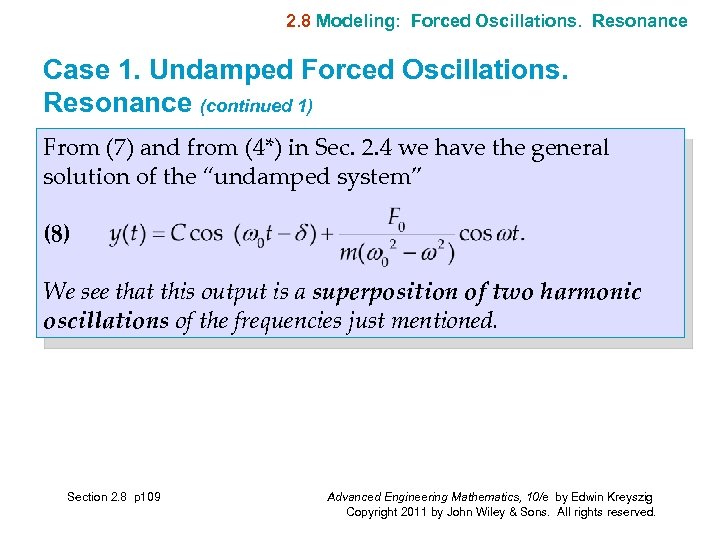 2. 8 Modeling: Forced Oscillations. Resonance Case 1. Undamped Forced Oscillations. Resonance (continued 1) From (7) and from (4*) in Sec. 2. 4 we have the general solution of the “undamped system” (8) We see that this output is a superposition of two harmonic oscillations of the frequencies just mentioned. Section 2. 8 p 109 Advanced Engineering Mathematics, 10/e by Edwin Kreyszig Copyright 2011 by John Wiley & Sons. All rights reserved.
2. 8 Modeling: Forced Oscillations. Resonance Case 1. Undamped Forced Oscillations. Resonance (continued 1) From (7) and from (4*) in Sec. 2. 4 we have the general solution of the “undamped system” (8) We see that this output is a superposition of two harmonic oscillations of the frequencies just mentioned. Section 2. 8 p 109 Advanced Engineering Mathematics, 10/e by Edwin Kreyszig Copyright 2011 by John Wiley & Sons. All rights reserved.
 2. 8 Modeling: Forced Oscillations. Resonance Case 1. Undamped Forced Oscillations. Resonance (continued 2) Resonance. We discuss (7). We see that the maximum amplitude of yp is (put cos ωt = 1) (9) a 0 depends on ω and ω0. If ω → ω0 , then ρ and a 0 tend to infinity. This excitation of large oscillations by matching input and natural frequencies (ω = ω0) is called resonance. ρ is called the resonance factor (Fig. 54), and from (9) we see that ρ /k = a 0/F 0 is the ratio of the amplitudes of the particular solution yp and of the input F 0 cos ωt. We shall see later in this section that resonance is of basic importance in the study of vibrating systems. Section 2. 8 p 110 Advanced Engineering Mathematics, 10/e by Edwin Kreyszig Copyright 2011 by John Wiley & Sons. All rights reserved.
2. 8 Modeling: Forced Oscillations. Resonance Case 1. Undamped Forced Oscillations. Resonance (continued 2) Resonance. We discuss (7). We see that the maximum amplitude of yp is (put cos ωt = 1) (9) a 0 depends on ω and ω0. If ω → ω0 , then ρ and a 0 tend to infinity. This excitation of large oscillations by matching input and natural frequencies (ω = ω0) is called resonance. ρ is called the resonance factor (Fig. 54), and from (9) we see that ρ /k = a 0/F 0 is the ratio of the amplitudes of the particular solution yp and of the input F 0 cos ωt. We shall see later in this section that resonance is of basic importance in the study of vibrating systems. Section 2. 8 p 110 Advanced Engineering Mathematics, 10/e by Edwin Kreyszig Copyright 2011 by John Wiley & Sons. All rights reserved.
 2. 8 Modeling: Forced Oscillations. Resonance Case 1. Undamped Forced Oscillations. Resonance (continued 3) Resonance. (continued) Fig. 54. Resonance factor ρ(ω) Section 2. 8 p 111 Advanced Engineering Mathematics, 10/e by Edwin Kreyszig Copyright 2011 by John Wiley & Sons. All rights reserved.
2. 8 Modeling: Forced Oscillations. Resonance Case 1. Undamped Forced Oscillations. Resonance (continued 3) Resonance. (continued) Fig. 54. Resonance factor ρ(ω) Section 2. 8 p 111 Advanced Engineering Mathematics, 10/e by Edwin Kreyszig Copyright 2011 by John Wiley & Sons. All rights reserved.
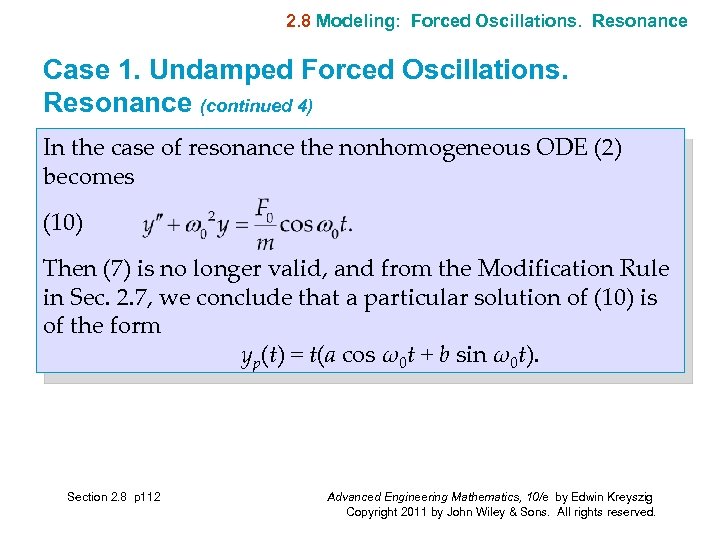 2. 8 Modeling: Forced Oscillations. Resonance Case 1. Undamped Forced Oscillations. Resonance (continued 4) In the case of resonance the nonhomogeneous ODE (2) becomes (10) Then (7) is no longer valid, and from the Modification Rule in Sec. 2. 7, we conclude that a particular solution of (10) is of the form yp(t) = t(a cos ω0 t + b sin ω0 t). Section 2. 8 p 112 Advanced Engineering Mathematics, 10/e by Edwin Kreyszig Copyright 2011 by John Wiley & Sons. All rights reserved.
2. 8 Modeling: Forced Oscillations. Resonance Case 1. Undamped Forced Oscillations. Resonance (continued 4) In the case of resonance the nonhomogeneous ODE (2) becomes (10) Then (7) is no longer valid, and from the Modification Rule in Sec. 2. 7, we conclude that a particular solution of (10) is of the form yp(t) = t(a cos ω0 t + b sin ω0 t). Section 2. 8 p 112 Advanced Engineering Mathematics, 10/e by Edwin Kreyszig Copyright 2011 by John Wiley & Sons. All rights reserved.
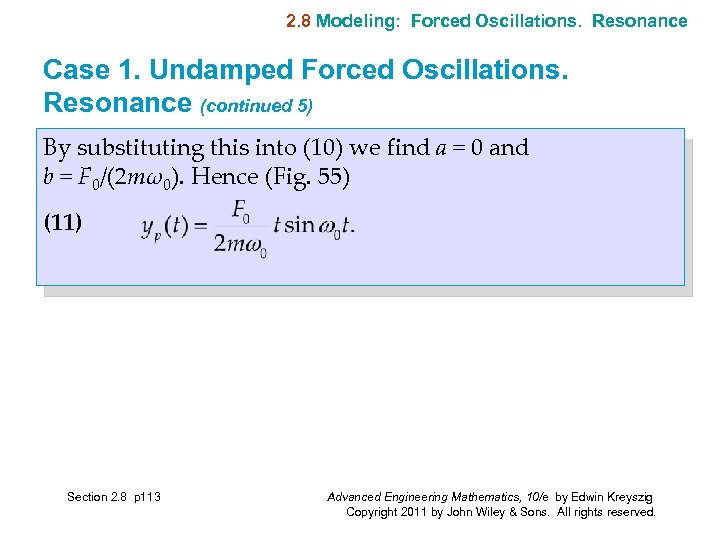 2. 8 Modeling: Forced Oscillations. Resonance Case 1. Undamped Forced Oscillations. Resonance (continued 5) By substituting this into (10) we find a = 0 and b = F 0/(2 mω0). Hence (Fig. 55) (11) Section 2. 8 p 113 Advanced Engineering Mathematics, 10/e by Edwin Kreyszig Copyright 2011 by John Wiley & Sons. All rights reserved.
2. 8 Modeling: Forced Oscillations. Resonance Case 1. Undamped Forced Oscillations. Resonance (continued 5) By substituting this into (10) we find a = 0 and b = F 0/(2 mω0). Hence (Fig. 55) (11) Section 2. 8 p 113 Advanced Engineering Mathematics, 10/e by Edwin Kreyszig Copyright 2011 by John Wiley & Sons. All rights reserved.
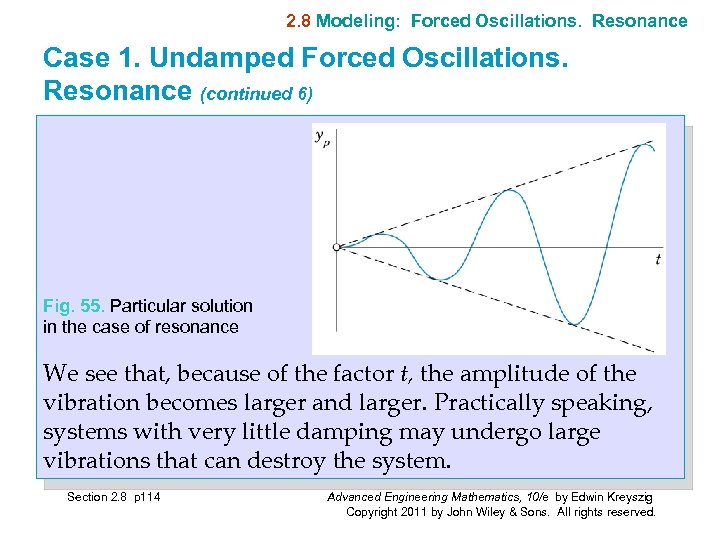 2. 8 Modeling: Forced Oscillations. Resonance Case 1. Undamped Forced Oscillations. Resonance (continued 6) Fig. 55. Particular solution in the case of resonance We see that, because of the factor t, the amplitude of the vibration becomes larger and larger. Practically speaking, systems with very little damping may undergo large vibrations that can destroy the system. Section 2. 8 p 114 Advanced Engineering Mathematics, 10/e by Edwin Kreyszig Copyright 2011 by John Wiley & Sons. All rights reserved.
2. 8 Modeling: Forced Oscillations. Resonance Case 1. Undamped Forced Oscillations. Resonance (continued 6) Fig. 55. Particular solution in the case of resonance We see that, because of the factor t, the amplitude of the vibration becomes larger and larger. Practically speaking, systems with very little damping may undergo large vibrations that can destroy the system. Section 2. 8 p 114 Advanced Engineering Mathematics, 10/e by Edwin Kreyszig Copyright 2011 by John Wiley & Sons. All rights reserved.
 2. 8 Modeling: Forced Oscillations. Resonance Case 1. Undamped Forced Oscillations. Resonance (continued 7) Beats. Another interesting and highly important type of oscillation is obtained if ω is close to ω0. Take, for example, the particular solution [see (8)] (12) Using (12) in App. 3. 1, we may write this as Section 2. 8 p 115 Advanced Engineering Mathematics, 10/e by Edwin Kreyszig Copyright 2011 by John Wiley & Sons. All rights reserved.
2. 8 Modeling: Forced Oscillations. Resonance Case 1. Undamped Forced Oscillations. Resonance (continued 7) Beats. Another interesting and highly important type of oscillation is obtained if ω is close to ω0. Take, for example, the particular solution [see (8)] (12) Using (12) in App. 3. 1, we may write this as Section 2. 8 p 115 Advanced Engineering Mathematics, 10/e by Edwin Kreyszig Copyright 2011 by John Wiley & Sons. All rights reserved.
 2. 8 Modeling: Forced Oscillations. Resonance Case 1. Undamped Forced Oscillations. Resonance (continued 8) Beats. (continued) Since is ω close to ω0, the difference ω0 − ω is small. Hence the period of the last sine function is large, and we obtain an oscillation of the type shown in Fig. 56, the dashed curve resulting from the first sine factor. This is what musicians are listening to when they tune their instruments. Section 2. 8 p 116 Advanced Engineering Mathematics, 10/e by Edwin Kreyszig Copyright 2011 by John Wiley & Sons. All rights reserved.
2. 8 Modeling: Forced Oscillations. Resonance Case 1. Undamped Forced Oscillations. Resonance (continued 8) Beats. (continued) Since is ω close to ω0, the difference ω0 − ω is small. Hence the period of the last sine function is large, and we obtain an oscillation of the type shown in Fig. 56, the dashed curve resulting from the first sine factor. This is what musicians are listening to when they tune their instruments. Section 2. 8 p 116 Advanced Engineering Mathematics, 10/e by Edwin Kreyszig Copyright 2011 by John Wiley & Sons. All rights reserved.
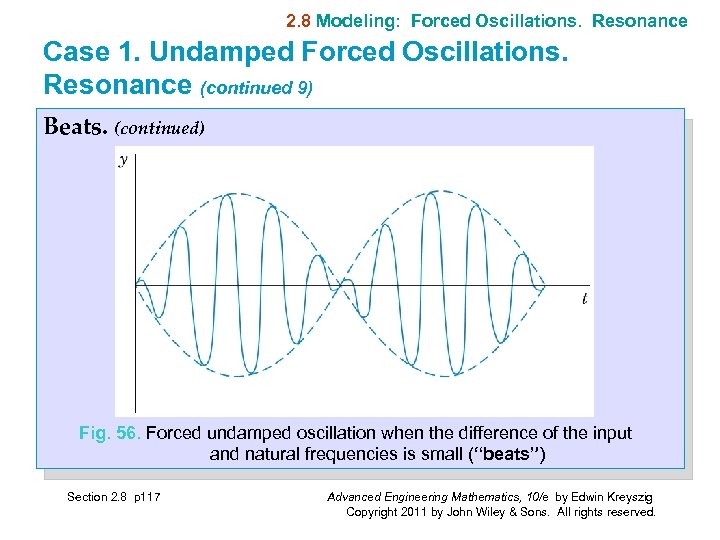 2. 8 Modeling: Forced Oscillations. Resonance Case 1. Undamped Forced Oscillations. Resonance (continued 9) Beats. (continued) Fig. 56. Forced undamped oscillation when the difference of the input and natural frequencies is small (“beats”) Section 2. 8 p 117 Advanced Engineering Mathematics, 10/e by Edwin Kreyszig Copyright 2011 by John Wiley & Sons. All rights reserved.
2. 8 Modeling: Forced Oscillations. Resonance Case 1. Undamped Forced Oscillations. Resonance (continued 9) Beats. (continued) Fig. 56. Forced undamped oscillation when the difference of the input and natural frequencies is small (“beats”) Section 2. 8 p 117 Advanced Engineering Mathematics, 10/e by Edwin Kreyszig Copyright 2011 by John Wiley & Sons. All rights reserved.
 2. 8 Modeling: Forced Oscillations. Resonance Case 2. Damped Forced Oscillations If the damping of the mass–spring system is not negligibly small, we have c > 0 and a damping term cy’ in (1) and (2). Then the general solution yh of the homogeneous ODE (1) approaches zero as t goes to infinity, as we know from Sec. 2. 4. Practically, it is zero after a sufficiently long time. Hence the “transient solution” (6) of (2), given by y = yh + yp, approaches the “steady-state solution” yp. This proves the following theorem. Section 2. 8 p 118 Advanced Engineering Mathematics, 10/e by Edwin Kreyszig Copyright 2011 by John Wiley & Sons. All rights reserved.
2. 8 Modeling: Forced Oscillations. Resonance Case 2. Damped Forced Oscillations If the damping of the mass–spring system is not negligibly small, we have c > 0 and a damping term cy’ in (1) and (2). Then the general solution yh of the homogeneous ODE (1) approaches zero as t goes to infinity, as we know from Sec. 2. 4. Practically, it is zero after a sufficiently long time. Hence the “transient solution” (6) of (2), given by y = yh + yp, approaches the “steady-state solution” yp. This proves the following theorem. Section 2. 8 p 118 Advanced Engineering Mathematics, 10/e by Edwin Kreyszig Copyright 2011 by John Wiley & Sons. All rights reserved.
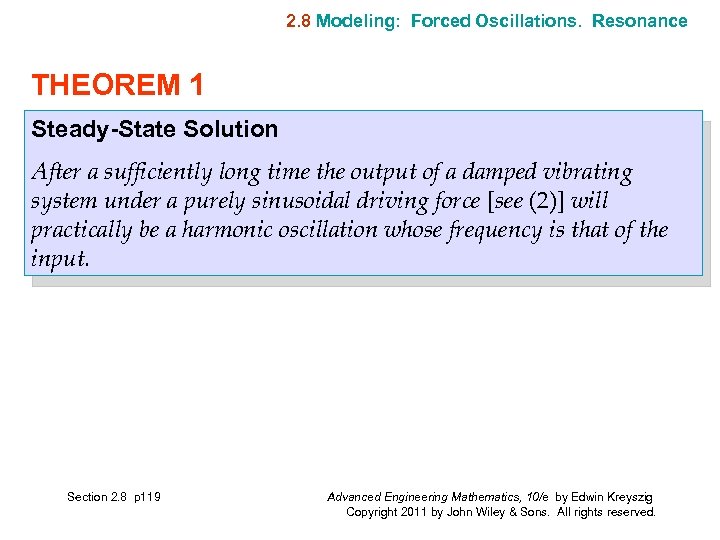 2. 8 Modeling: Forced Oscillations. Resonance THEOREM 1 Steady-State Solution After a sufficiently long time the output of a damped vibrating system under a purely sinusoidal driving force [see (2)] will practically be a harmonic oscillation whose frequency is that of the input. Section 2. 8 p 119 Advanced Engineering Mathematics, 10/e by Edwin Kreyszig Copyright 2011 by John Wiley & Sons. All rights reserved.
2. 8 Modeling: Forced Oscillations. Resonance THEOREM 1 Steady-State Solution After a sufficiently long time the output of a damped vibrating system under a purely sinusoidal driving force [see (2)] will practically be a harmonic oscillation whose frequency is that of the input. Section 2. 8 p 119 Advanced Engineering Mathematics, 10/e by Edwin Kreyszig Copyright 2011 by John Wiley & Sons. All rights reserved.
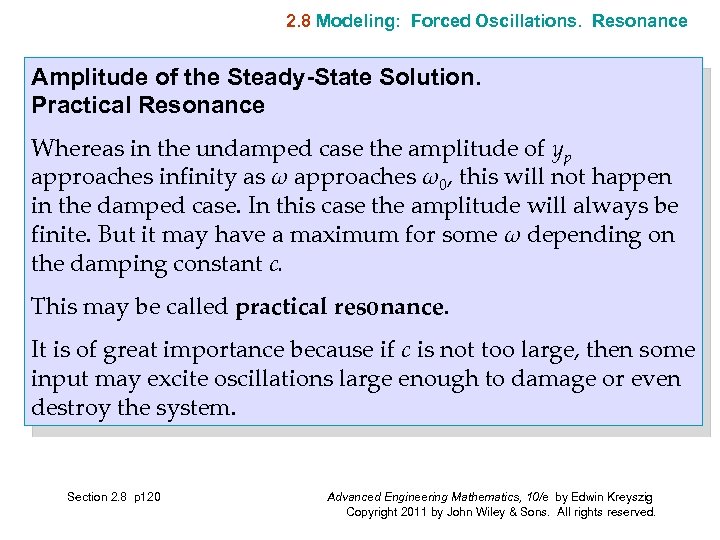 2. 8 Modeling: Forced Oscillations. Resonance Amplitude of the Steady-State Solution. Practical Resonance Whereas in the undamped case the amplitude of yp approaches infinity as ω approaches ω0, this will not happen in the damped case. In this case the amplitude will always be finite. But it may have a maximum for some ω depending on the damping constant c. This may be called practical resonance. It is of great importance because if c is not too large, then some input may excite oscillations large enough to damage or even destroy the system. Section 2. 8 p 120 Advanced Engineering Mathematics, 10/e by Edwin Kreyszig Copyright 2011 by John Wiley & Sons. All rights reserved.
2. 8 Modeling: Forced Oscillations. Resonance Amplitude of the Steady-State Solution. Practical Resonance Whereas in the undamped case the amplitude of yp approaches infinity as ω approaches ω0, this will not happen in the damped case. In this case the amplitude will always be finite. But it may have a maximum for some ω depending on the damping constant c. This may be called practical resonance. It is of great importance because if c is not too large, then some input may excite oscillations large enough to damage or even destroy the system. Section 2. 8 p 120 Advanced Engineering Mathematics, 10/e by Edwin Kreyszig Copyright 2011 by John Wiley & Sons. All rights reserved.
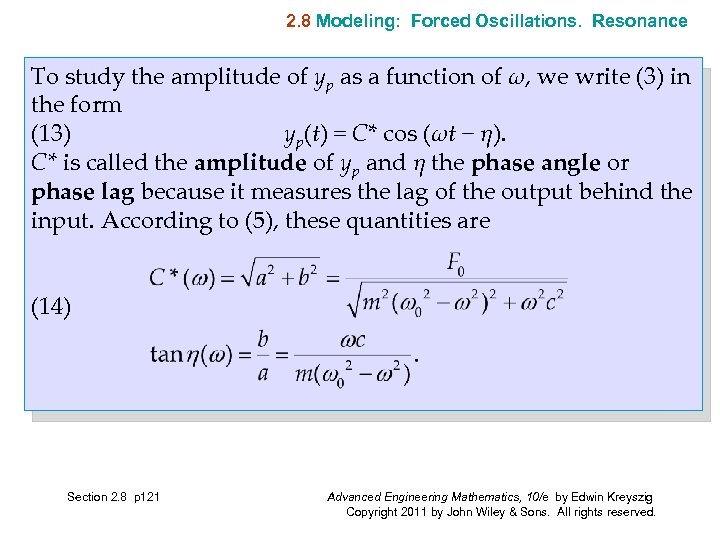 2. 8 Modeling: Forced Oscillations. Resonance To study the amplitude of yp as a function of ω, we write (3) in the form (13) yp(t) = C* cos (ωt − η). C* is called the amplitude of yp and η the phase angle or phase lag because it measures the lag of the output behind the input. According to (5), these quantities are (14) Section 2. 8 p 121 Advanced Engineering Mathematics, 10/e by Edwin Kreyszig Copyright 2011 by John Wiley & Sons. All rights reserved.
2. 8 Modeling: Forced Oscillations. Resonance To study the amplitude of yp as a function of ω, we write (3) in the form (13) yp(t) = C* cos (ωt − η). C* is called the amplitude of yp and η the phase angle or phase lag because it measures the lag of the output behind the input. According to (5), these quantities are (14) Section 2. 8 p 121 Advanced Engineering Mathematics, 10/e by Edwin Kreyszig Copyright 2011 by John Wiley & Sons. All rights reserved.
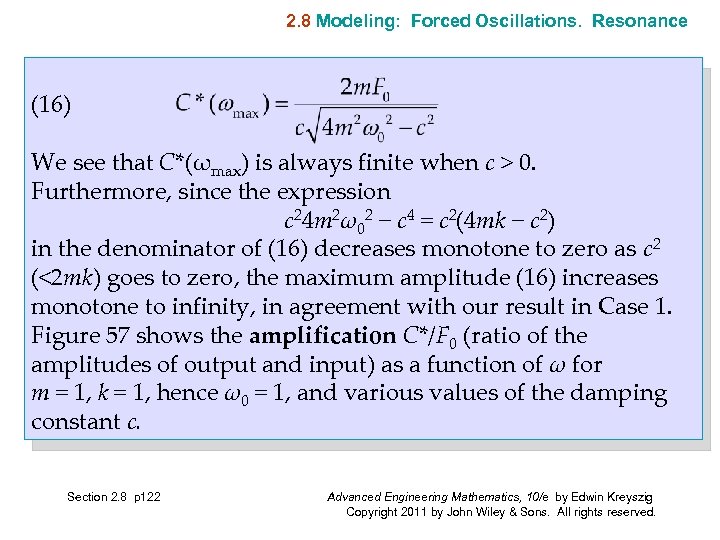 2. 8 Modeling: Forced Oscillations. Resonance (16) We see that C*(ωmax) is always finite when c > 0. Furthermore, since the expression c 24 m 2ω02 − c 4 = c 2(4 mk − c 2) in the denominator of (16) decreases monotone to zero as c 2 (<2 mk) goes to zero, the maximum amplitude (16) increases monotone to infinity, in agreement with our result in Case 1. Figure 57 shows the amplification C*/F 0 (ratio of the amplitudes of output and input) as a function of ω for m = 1, k = 1, hence ω0 = 1, and various values of the damping constant c. Section 2. 8 p 122 Advanced Engineering Mathematics, 10/e by Edwin Kreyszig Copyright 2011 by John Wiley & Sons. All rights reserved.
2. 8 Modeling: Forced Oscillations. Resonance (16) We see that C*(ωmax) is always finite when c > 0. Furthermore, since the expression c 24 m 2ω02 − c 4 = c 2(4 mk − c 2) in the denominator of (16) decreases monotone to zero as c 2 (<2 mk) goes to zero, the maximum amplitude (16) increases monotone to infinity, in agreement with our result in Case 1. Figure 57 shows the amplification C*/F 0 (ratio of the amplitudes of output and input) as a function of ω for m = 1, k = 1, hence ω0 = 1, and various values of the damping constant c. Section 2. 8 p 122 Advanced Engineering Mathematics, 10/e by Edwin Kreyszig Copyright 2011 by John Wiley & Sons. All rights reserved.
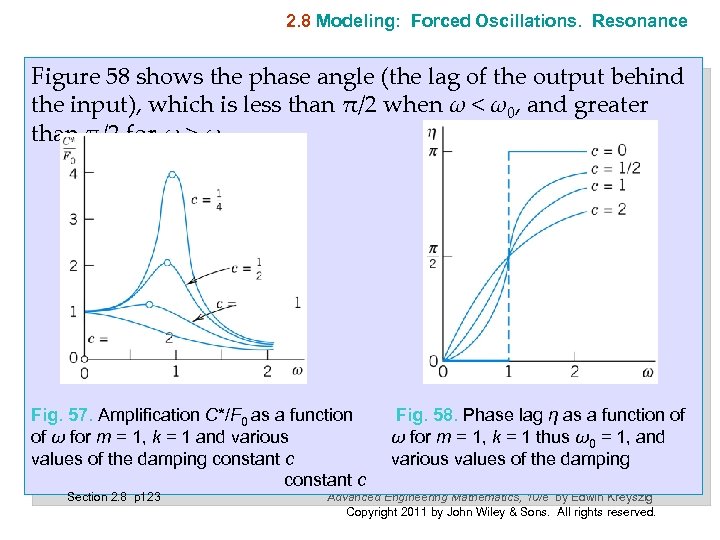 2. 8 Modeling: Forced Oscillations. Resonance Figure 58 shows the phase angle (the lag of the output behind the input), which is less than π/2 when ω < ω0, and greater than π/2 for ω > ω0. Fig. 57. Amplification C*/F 0 as a function of ω for m = 1, k = 1 and various values of the damping constant c Section 2. 8 p 123 Fig. 58. Phase lag η as a function of ω for m = 1, k = 1 thus ω0 = 1, and various values of the damping Advanced Engineering Mathematics, 10/e by Edwin Kreyszig Copyright 2011 by John Wiley & Sons. All rights reserved.
2. 8 Modeling: Forced Oscillations. Resonance Figure 58 shows the phase angle (the lag of the output behind the input), which is less than π/2 when ω < ω0, and greater than π/2 for ω > ω0. Fig. 57. Amplification C*/F 0 as a function of ω for m = 1, k = 1 and various values of the damping constant c Section 2. 8 p 123 Fig. 58. Phase lag η as a function of ω for m = 1, k = 1 thus ω0 = 1, and various values of the damping Advanced Engineering Mathematics, 10/e by Edwin Kreyszig Copyright 2011 by John Wiley & Sons. All rights reserved.
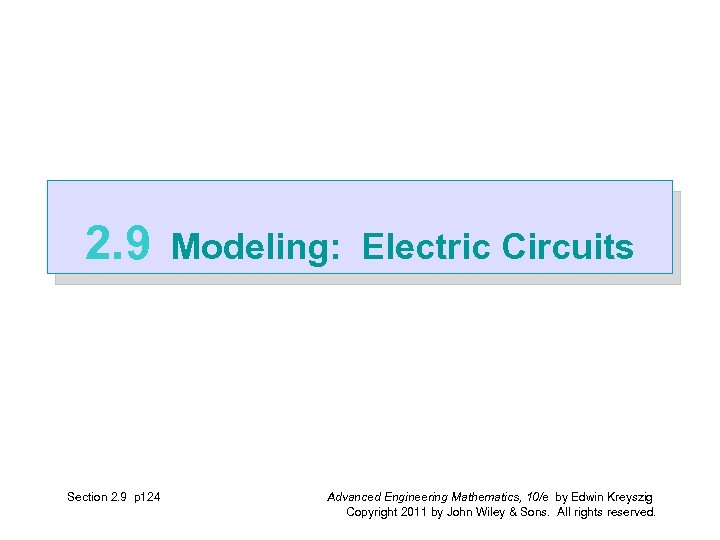 2. 9 Section 2. 9 p 124 Modeling: Electric Circuits Advanced Engineering Mathematics, 10/e by Edwin Kreyszig Copyright 2011 by John Wiley & Sons. All rights reserved.
2. 9 Section 2. 9 p 124 Modeling: Electric Circuits Advanced Engineering Mathematics, 10/e by Edwin Kreyszig Copyright 2011 by John Wiley & Sons. All rights reserved.
 2. 9 Modeling: Electric Circuits Figure 61 shows an RLC-circuit, as it occurs as a basic building block of large electric networks in computers and elsewhere. An RLC-circuit is obtained from an RL-circuit by adding a capacitor. Recall Example 2 on the RL-circuit in Sec. 1. 5: The model of the RL-circuit is LI’ + RI = E(t). It was obtained by KVL (Kirchhoff’s Voltage Law)* by equating the voltage drops across the resistor and the inductor to the EMF (electromotive force). *Kirchhoff’s Current Law (KCL): At any point of a circuit, the sum of the inflowing currents is equal to the sum of the outflowing currents. Section 2. 9 p 125 Advanced Engineering Mathematics, 10/e by Edwin Kreyszig Copyright 2011 by John Wiley & Sons. All rights reserved.
2. 9 Modeling: Electric Circuits Figure 61 shows an RLC-circuit, as it occurs as a basic building block of large electric networks in computers and elsewhere. An RLC-circuit is obtained from an RL-circuit by adding a capacitor. Recall Example 2 on the RL-circuit in Sec. 1. 5: The model of the RL-circuit is LI’ + RI = E(t). It was obtained by KVL (Kirchhoff’s Voltage Law)* by equating the voltage drops across the resistor and the inductor to the EMF (electromotive force). *Kirchhoff’s Current Law (KCL): At any point of a circuit, the sum of the inflowing currents is equal to the sum of the outflowing currents. Section 2. 9 p 125 Advanced Engineering Mathematics, 10/e by Edwin Kreyszig Copyright 2011 by John Wiley & Sons. All rights reserved.
 2. 9 Modeling: Electric Circuits Hence we obtain the model of the RLC-circuit simply by adding the voltage drop Q/C across the capacitor. Here, C F(farads) is the capacitance of the capacitor. Q coulombs is the charge on the capacitor, related to the current by Section 2. 9 p 126 Advanced Engineering Mathematics, 10/e by Edwin Kreyszig Copyright 2011 by John Wiley & Sons. All rights reserved.
2. 9 Modeling: Electric Circuits Hence we obtain the model of the RLC-circuit simply by adding the voltage drop Q/C across the capacitor. Here, C F(farads) is the capacitance of the capacitor. Q coulombs is the charge on the capacitor, related to the current by Section 2. 9 p 126 Advanced Engineering Mathematics, 10/e by Edwin Kreyszig Copyright 2011 by John Wiley & Sons. All rights reserved.
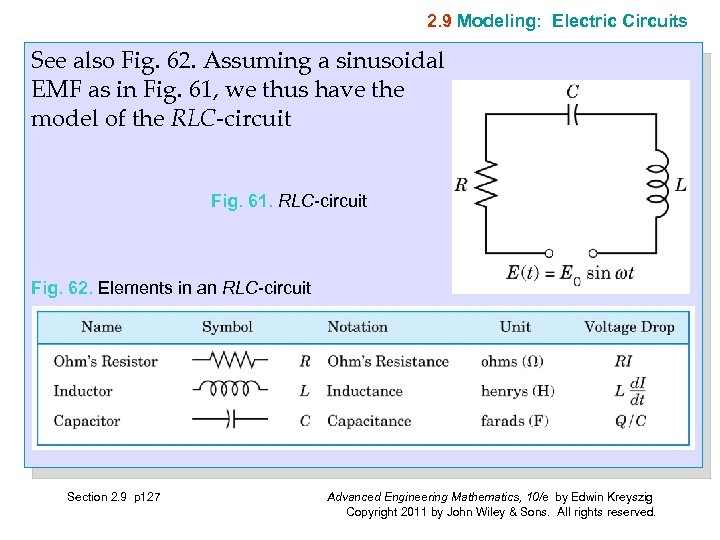 2. 9 Modeling: Electric Circuits See also Fig. 62. Assuming a sinusoidal EMF as in Fig. 61, we thus have the model of the RLC-circuit Fig. 61. RLC-circuit Fig. 62. Elements in an RLC-circuit Section 2. 9 p 127 Advanced Engineering Mathematics, 10/e by Edwin Kreyszig Copyright 2011 by John Wiley & Sons. All rights reserved.
2. 9 Modeling: Electric Circuits See also Fig. 62. Assuming a sinusoidal EMF as in Fig. 61, we thus have the model of the RLC-circuit Fig. 61. RLC-circuit Fig. 62. Elements in an RLC-circuit Section 2. 9 p 127 Advanced Engineering Mathematics, 10/e by Edwin Kreyszig Copyright 2011 by John Wiley & Sons. All rights reserved.
 2. 9 Modeling: Electric Circuits (1’) This is an “integro-differential equation. ” To get rid of the integral, we differentiate (1’) with respect to t, obtaining (1) This shows that the current in an RLC-circuit is obtained as the solution of this nonhomogeneous second-order ODE (1) with constant coefficients. In connection with initial value problems, we shall occasionally use (1”) obtained from (1’) and I = Q’. Section 2. 9 p 128 Advanced Engineering Mathematics, 10/e by Edwin Kreyszig Copyright 2011 by John Wiley & Sons. All rights reserved.
2. 9 Modeling: Electric Circuits (1’) This is an “integro-differential equation. ” To get rid of the integral, we differentiate (1’) with respect to t, obtaining (1) This shows that the current in an RLC-circuit is obtained as the solution of this nonhomogeneous second-order ODE (1) with constant coefficients. In connection with initial value problems, we shall occasionally use (1”) obtained from (1’) and I = Q’. Section 2. 9 p 128 Advanced Engineering Mathematics, 10/e by Edwin Kreyszig Copyright 2011 by John Wiley & Sons. All rights reserved.
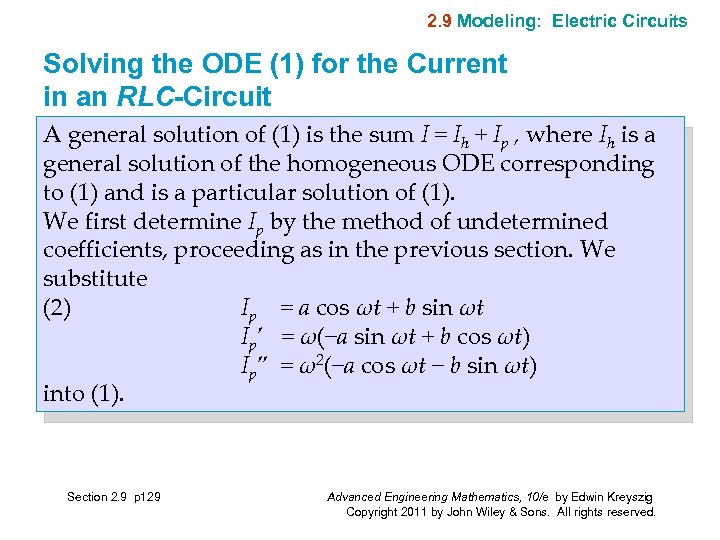 2. 9 Modeling: Electric Circuits Solving the ODE (1) for the Current in an RLC-Circuit A general solution of (1) is the sum I = Ih + Ip , where Ih is a general solution of the homogeneous ODE corresponding to (1) and is a particular solution of (1). We first determine Ip by the method of undetermined coefficients, proceeding as in the previous section. We substitute (2) Ip = a cos ωt + b sin ωt Ip’ = ω(−a sin ωt + b cos ωt) Ip” = ω2(−a cos ωt − b sin ωt) into (1). Section 2. 9 p 129 Advanced Engineering Mathematics, 10/e by Edwin Kreyszig Copyright 2011 by John Wiley & Sons. All rights reserved.
2. 9 Modeling: Electric Circuits Solving the ODE (1) for the Current in an RLC-Circuit A general solution of (1) is the sum I = Ih + Ip , where Ih is a general solution of the homogeneous ODE corresponding to (1) and is a particular solution of (1). We first determine Ip by the method of undetermined coefficients, proceeding as in the previous section. We substitute (2) Ip = a cos ωt + b sin ωt Ip’ = ω(−a sin ωt + b cos ωt) Ip” = ω2(−a cos ωt − b sin ωt) into (1). Section 2. 9 p 129 Advanced Engineering Mathematics, 10/e by Edwin Kreyszig Copyright 2011 by John Wiley & Sons. All rights reserved.
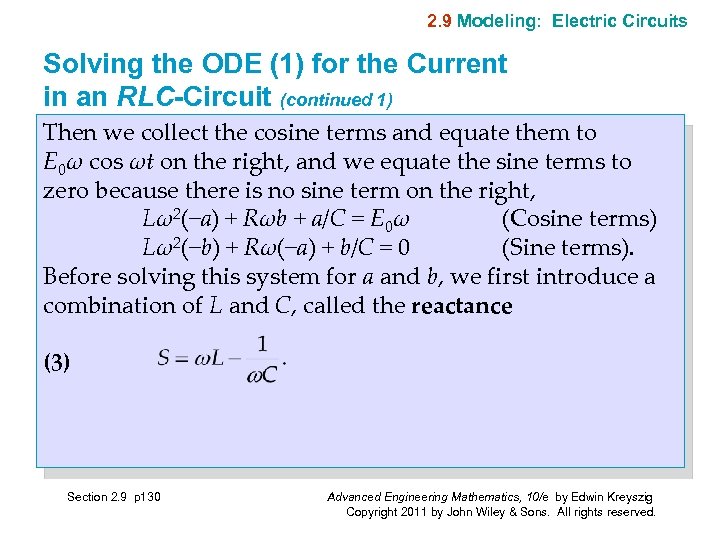 2. 9 Modeling: Electric Circuits Solving the ODE (1) for the Current in an RLC-Circuit (continued 1) Then we collect the cosine terms and equate them to E 0ω cos ωt on the right, and we equate the sine terms to zero because there is no sine term on the right, Lω2(−a) + Rωb + a/C = E 0ω (Cosine terms) Lω2(−b) + Rω(−a) + b/C = 0 (Sine terms). Before solving this system for a and b, we first introduce a combination of L and C, called the reactance (3) Section 2. 9 p 130 Advanced Engineering Mathematics, 10/e by Edwin Kreyszig Copyright 2011 by John Wiley & Sons. All rights reserved.
2. 9 Modeling: Electric Circuits Solving the ODE (1) for the Current in an RLC-Circuit (continued 1) Then we collect the cosine terms and equate them to E 0ω cos ωt on the right, and we equate the sine terms to zero because there is no sine term on the right, Lω2(−a) + Rωb + a/C = E 0ω (Cosine terms) Lω2(−b) + Rω(−a) + b/C = 0 (Sine terms). Before solving this system for a and b, we first introduce a combination of L and C, called the reactance (3) Section 2. 9 p 130 Advanced Engineering Mathematics, 10/e by Edwin Kreyszig Copyright 2011 by John Wiley & Sons. All rights reserved.
 2. 9 Modeling: Electric Circuits Solving the ODE (1) for the Current in an RLC-Circuit (continued 2) We can solve for a and b, (4) Equation (2) with coefficients a and b given by (4) is the desired particular solution Ip of the nonhomogeneous ODE (1) governing the current I in an RLC-circuit with sinusoidal electromotive force. Section 2. 9 p 131 Advanced Engineering Mathematics, 10/e by Edwin Kreyszig Copyright 2011 by John Wiley & Sons. All rights reserved.
2. 9 Modeling: Electric Circuits Solving the ODE (1) for the Current in an RLC-Circuit (continued 2) We can solve for a and b, (4) Equation (2) with coefficients a and b given by (4) is the desired particular solution Ip of the nonhomogeneous ODE (1) governing the current I in an RLC-circuit with sinusoidal electromotive force. Section 2. 9 p 131 Advanced Engineering Mathematics, 10/e by Edwin Kreyszig Copyright 2011 by John Wiley & Sons. All rights reserved.
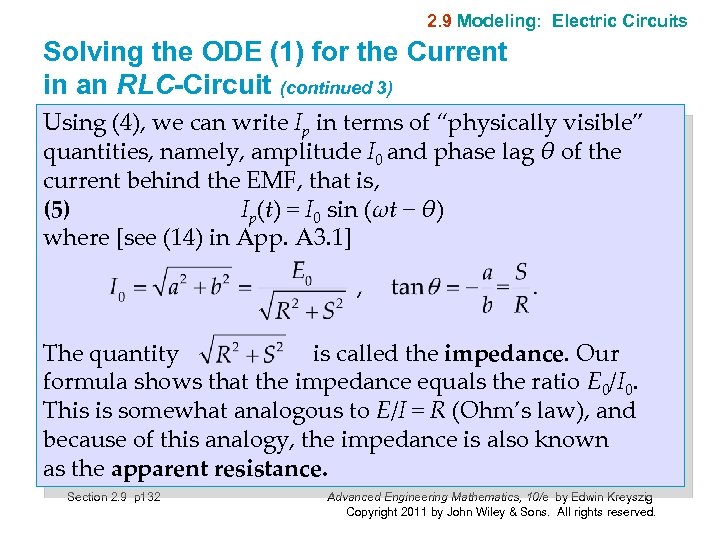 2. 9 Modeling: Electric Circuits Solving the ODE (1) for the Current in an RLC-Circuit (continued 3) Using (4), we can write Ip in terms of “physically visible” quantities, namely, amplitude I 0 and phase lag θ of the current behind the EMF, that is, (5) Ip(t) = I 0 sin (ωt − θ) where [see (14) in App. A 3. 1] The quantity is called the impedance. Our formula shows that the impedance equals the ratio E 0/I 0. This is somewhat analogous to E/I = R (Ohm’s law), and because of this analogy, the impedance is also known as the apparent resistance. Section 2. 9 p 132 Advanced Engineering Mathematics, 10/e by Edwin Kreyszig Copyright 2011 by John Wiley & Sons. All rights reserved.
2. 9 Modeling: Electric Circuits Solving the ODE (1) for the Current in an RLC-Circuit (continued 3) Using (4), we can write Ip in terms of “physically visible” quantities, namely, amplitude I 0 and phase lag θ of the current behind the EMF, that is, (5) Ip(t) = I 0 sin (ωt − θ) where [see (14) in App. A 3. 1] The quantity is called the impedance. Our formula shows that the impedance equals the ratio E 0/I 0. This is somewhat analogous to E/I = R (Ohm’s law), and because of this analogy, the impedance is also known as the apparent resistance. Section 2. 9 p 132 Advanced Engineering Mathematics, 10/e by Edwin Kreyszig Copyright 2011 by John Wiley & Sons. All rights reserved.
 2. 9 Modeling: Electric Circuits Solving the ODE (1) for the Current in an RLC-Circuit (continued 4) A general solution of the homogeneous equation corresponding to (1) is where λ 1 and λ 2 are the roots of the characteristic equation Section 2. 9 p 133 Advanced Engineering Mathematics, 10/e by Edwin Kreyszig Copyright 2011 by John Wiley & Sons. All rights reserved.
2. 9 Modeling: Electric Circuits Solving the ODE (1) for the Current in an RLC-Circuit (continued 4) A general solution of the homogeneous equation corresponding to (1) is where λ 1 and λ 2 are the roots of the characteristic equation Section 2. 9 p 133 Advanced Engineering Mathematics, 10/e by Edwin Kreyszig Copyright 2011 by John Wiley & Sons. All rights reserved.
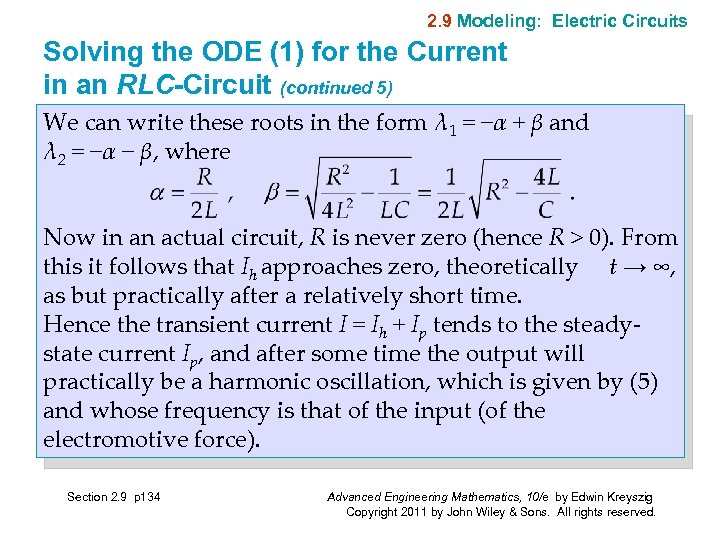 2. 9 Modeling: Electric Circuits Solving the ODE (1) for the Current in an RLC-Circuit (continued 5) We can write these roots in the form λ 1 = −α + β and λ 2 = −α − β, where Now in an actual circuit, R is never zero (hence R > 0). From this it follows that Ih approaches zero, theoretically t → ∞, as but practically after a relatively short time. Hence the transient current I = Ih + Ip tends to the steadystate current Ip, and after some time the output will practically be a harmonic oscillation, which is given by (5) and whose frequency is that of the input (of the electromotive force). Section 2. 9 p 134 Advanced Engineering Mathematics, 10/e by Edwin Kreyszig Copyright 2011 by John Wiley & Sons. All rights reserved.
2. 9 Modeling: Electric Circuits Solving the ODE (1) for the Current in an RLC-Circuit (continued 5) We can write these roots in the form λ 1 = −α + β and λ 2 = −α − β, where Now in an actual circuit, R is never zero (hence R > 0). From this it follows that Ih approaches zero, theoretically t → ∞, as but practically after a relatively short time. Hence the transient current I = Ih + Ip tends to the steadystate current Ip, and after some time the output will practically be a harmonic oscillation, which is given by (5) and whose frequency is that of the input (of the electromotive force). Section 2. 9 p 134 Advanced Engineering Mathematics, 10/e by Edwin Kreyszig Copyright 2011 by John Wiley & Sons. All rights reserved.
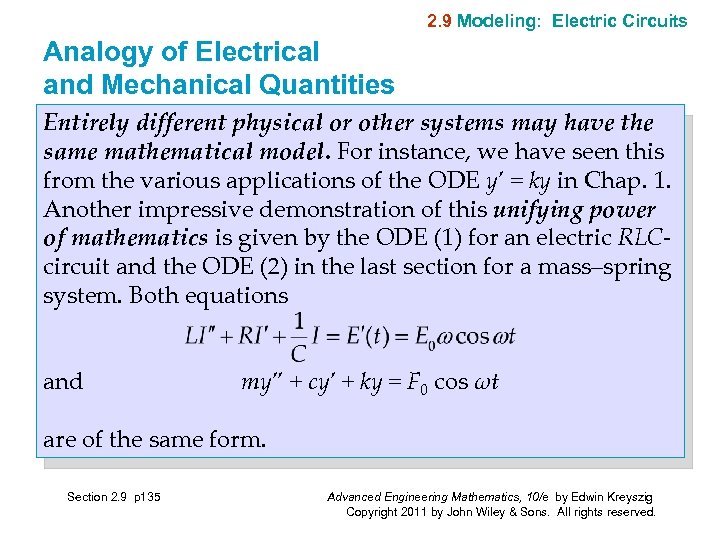 2. 9 Modeling: Electric Circuits Analogy of Electrical and Mechanical Quantities Entirely different physical or other systems may have the same mathematical model. For instance, we have seen this from the various applications of the ODE y’ = ky in Chap. 1. Another impressive demonstration of this unifying power of mathematics is given by the ODE (1) for an electric RLCcircuit and the ODE (2) in the last section for a mass–spring system. Both equations and my” + cy’ + ky = F 0 cos ωt are of the same form. Section 2. 9 p 135 Advanced Engineering Mathematics, 10/e by Edwin Kreyszig Copyright 2011 by John Wiley & Sons. All rights reserved.
2. 9 Modeling: Electric Circuits Analogy of Electrical and Mechanical Quantities Entirely different physical or other systems may have the same mathematical model. For instance, we have seen this from the various applications of the ODE y’ = ky in Chap. 1. Another impressive demonstration of this unifying power of mathematics is given by the ODE (1) for an electric RLCcircuit and the ODE (2) in the last section for a mass–spring system. Both equations and my” + cy’ + ky = F 0 cos ωt are of the same form. Section 2. 9 p 135 Advanced Engineering Mathematics, 10/e by Edwin Kreyszig Copyright 2011 by John Wiley & Sons. All rights reserved.
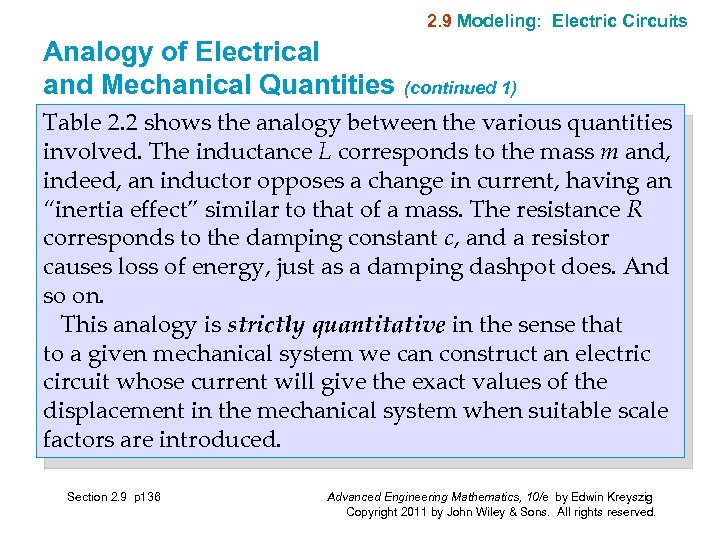 2. 9 Modeling: Electric Circuits Analogy of Electrical and Mechanical Quantities (continued 1) Table 2. 2 shows the analogy between the various quantities involved. The inductance L corresponds to the mass m and, indeed, an inductor opposes a change in current, having an “inertia effect” similar to that of a mass. The resistance R corresponds to the damping constant c, and a resistor causes loss of energy, just as a damping dashpot does. And so on. This analogy is strictly quantitative in the sense that to a given mechanical system we can construct an electric circuit whose current will give the exact values of the displacement in the mechanical system when suitable scale factors are introduced. Section 2. 9 p 136 Advanced Engineering Mathematics, 10/e by Edwin Kreyszig Copyright 2011 by John Wiley & Sons. All rights reserved.
2. 9 Modeling: Electric Circuits Analogy of Electrical and Mechanical Quantities (continued 1) Table 2. 2 shows the analogy between the various quantities involved. The inductance L corresponds to the mass m and, indeed, an inductor opposes a change in current, having an “inertia effect” similar to that of a mass. The resistance R corresponds to the damping constant c, and a resistor causes loss of energy, just as a damping dashpot does. And so on. This analogy is strictly quantitative in the sense that to a given mechanical system we can construct an electric circuit whose current will give the exact values of the displacement in the mechanical system when suitable scale factors are introduced. Section 2. 9 p 136 Advanced Engineering Mathematics, 10/e by Edwin Kreyszig Copyright 2011 by John Wiley & Sons. All rights reserved.
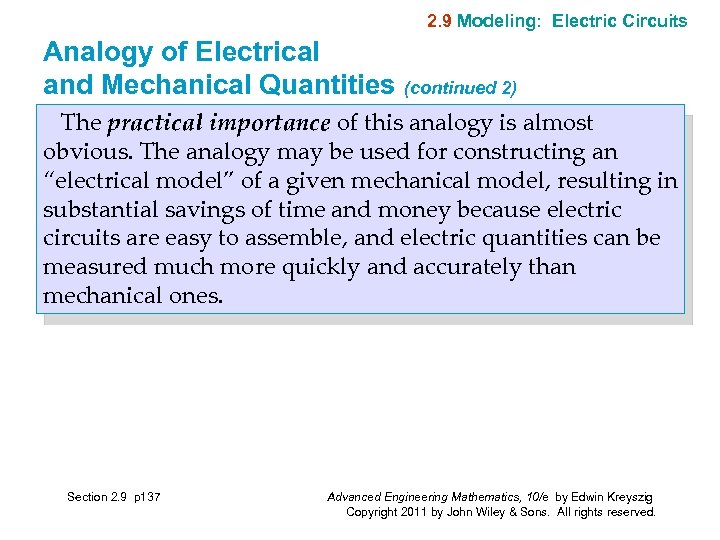 2. 9 Modeling: Electric Circuits Analogy of Electrical and Mechanical Quantities (continued 2) The practical importance of this analogy is almost obvious. The analogy may be used for constructing an “electrical model” of a given mechanical model, resulting in substantial savings of time and money because electric circuits are easy to assemble, and electric quantities can be measured much more quickly and accurately than mechanical ones. Section 2. 9 p 137 Advanced Engineering Mathematics, 10/e by Edwin Kreyszig Copyright 2011 by John Wiley & Sons. All rights reserved.
2. 9 Modeling: Electric Circuits Analogy of Electrical and Mechanical Quantities (continued 2) The practical importance of this analogy is almost obvious. The analogy may be used for constructing an “electrical model” of a given mechanical model, resulting in substantial savings of time and money because electric circuits are easy to assemble, and electric quantities can be measured much more quickly and accurately than mechanical ones. Section 2. 9 p 137 Advanced Engineering Mathematics, 10/e by Edwin Kreyszig Copyright 2011 by John Wiley & Sons. All rights reserved.
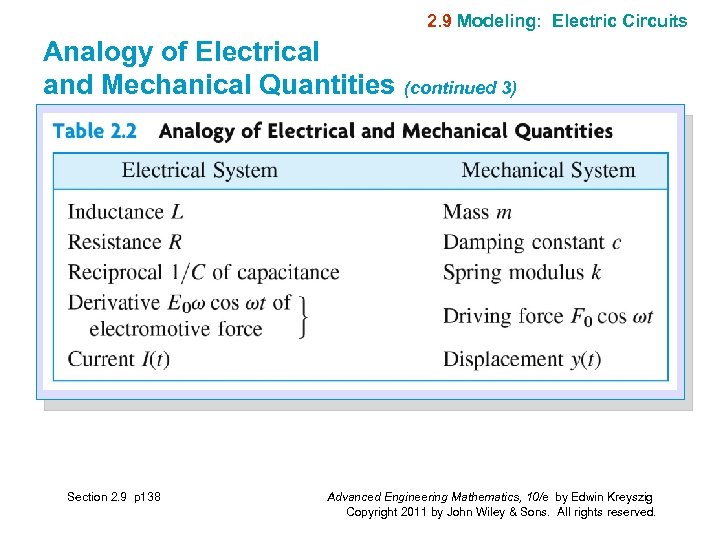 2. 9 Modeling: Electric Circuits Analogy of Electrical and Mechanical Quantities (continued 3) Section 2. 9 p 138 Advanced Engineering Mathematics, 10/e by Edwin Kreyszig Copyright 2011 by John Wiley & Sons. All rights reserved.
2. 9 Modeling: Electric Circuits Analogy of Electrical and Mechanical Quantities (continued 3) Section 2. 9 p 138 Advanced Engineering Mathematics, 10/e by Edwin Kreyszig Copyright 2011 by John Wiley & Sons. All rights reserved.
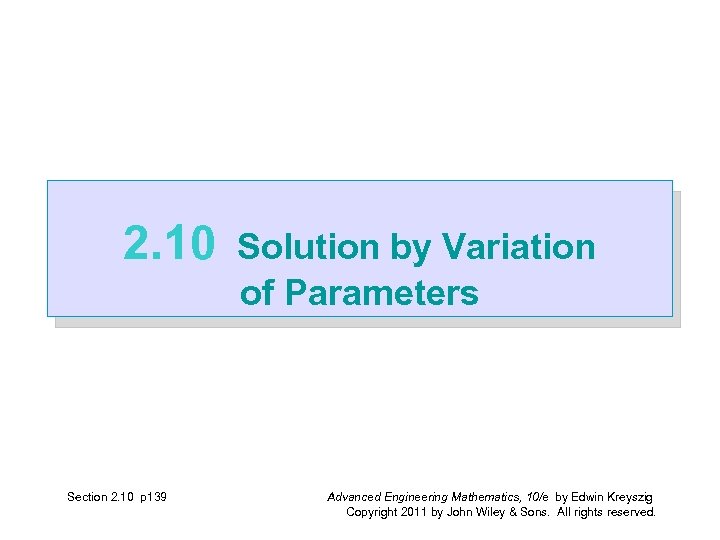 2. 10 Section 2. 10 p 139 Solution by Variation of Parameters Advanced Engineering Mathematics, 10/e by Edwin Kreyszig Copyright 2011 by John Wiley & Sons. All rights reserved.
2. 10 Section 2. 10 p 139 Solution by Variation of Parameters Advanced Engineering Mathematics, 10/e by Edwin Kreyszig Copyright 2011 by John Wiley & Sons. All rights reserved.
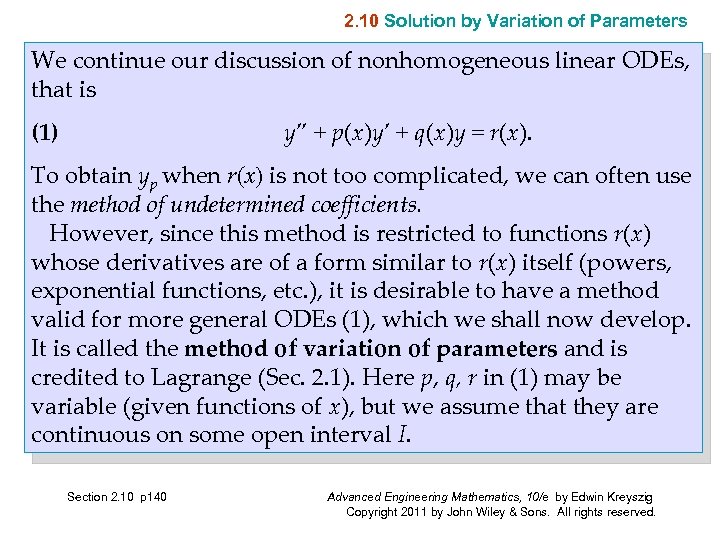 2. 10 Solution by Variation of Parameters We continue our discussion of nonhomogeneous linear ODEs, that is (1) y” + p(x)y’ + q(x)y = r(x). To obtain yp when r(x) is not too complicated, we can often use the method of undetermined coefficients. However, since this method is restricted to functions r(x) whose derivatives are of a form similar to r(x) itself (powers, exponential functions, etc. ), it is desirable to have a method valid for more general ODEs (1), which we shall now develop. It is called the method of variation of parameters and is credited to Lagrange (Sec. 2. 1). Here p, q, r in (1) may be variable (given functions of x), but we assume that they are continuous on some open interval I. Section 2. 10 p 140 Advanced Engineering Mathematics, 10/e by Edwin Kreyszig Copyright 2011 by John Wiley & Sons. All rights reserved.
2. 10 Solution by Variation of Parameters We continue our discussion of nonhomogeneous linear ODEs, that is (1) y” + p(x)y’ + q(x)y = r(x). To obtain yp when r(x) is not too complicated, we can often use the method of undetermined coefficients. However, since this method is restricted to functions r(x) whose derivatives are of a form similar to r(x) itself (powers, exponential functions, etc. ), it is desirable to have a method valid for more general ODEs (1), which we shall now develop. It is called the method of variation of parameters and is credited to Lagrange (Sec. 2. 1). Here p, q, r in (1) may be variable (given functions of x), but we assume that they are continuous on some open interval I. Section 2. 10 p 140 Advanced Engineering Mathematics, 10/e by Edwin Kreyszig Copyright 2011 by John Wiley & Sons. All rights reserved.
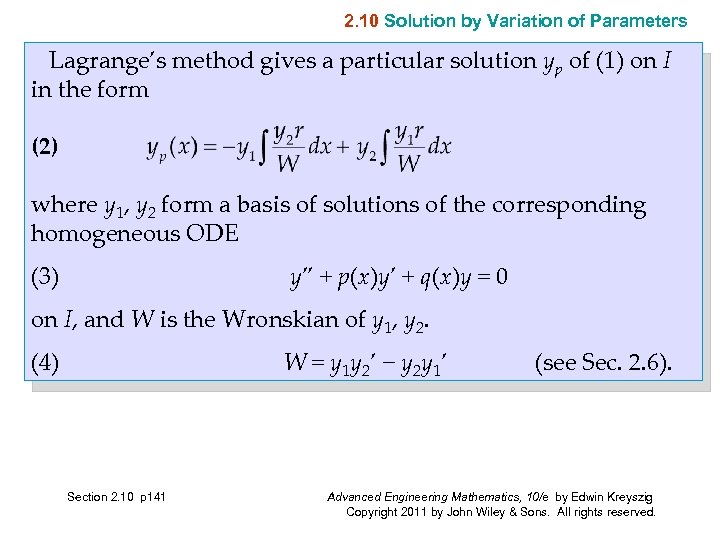 2. 10 Solution by Variation of Parameters Lagrange’s method gives a particular solution yp of (1) on I in the form (2) where y 1, y 2 form a basis of solutions of the corresponding homogeneous ODE (3) y” + p(x)y’ + q(x)y = 0 on I, and W is the Wronskian of y 1, y 2. (4) W = y 1 y 2’ − y 2 y 1’ Section 2. 10 p 141 (see Sec. 2. 6). Advanced Engineering Mathematics, 10/e by Edwin Kreyszig Copyright 2011 by John Wiley & Sons. All rights reserved.
2. 10 Solution by Variation of Parameters Lagrange’s method gives a particular solution yp of (1) on I in the form (2) where y 1, y 2 form a basis of solutions of the corresponding homogeneous ODE (3) y” + p(x)y’ + q(x)y = 0 on I, and W is the Wronskian of y 1, y 2. (4) W = y 1 y 2’ − y 2 y 1’ Section 2. 10 p 141 (see Sec. 2. 6). Advanced Engineering Mathematics, 10/e by Edwin Kreyszig Copyright 2011 by John Wiley & Sons. All rights reserved.
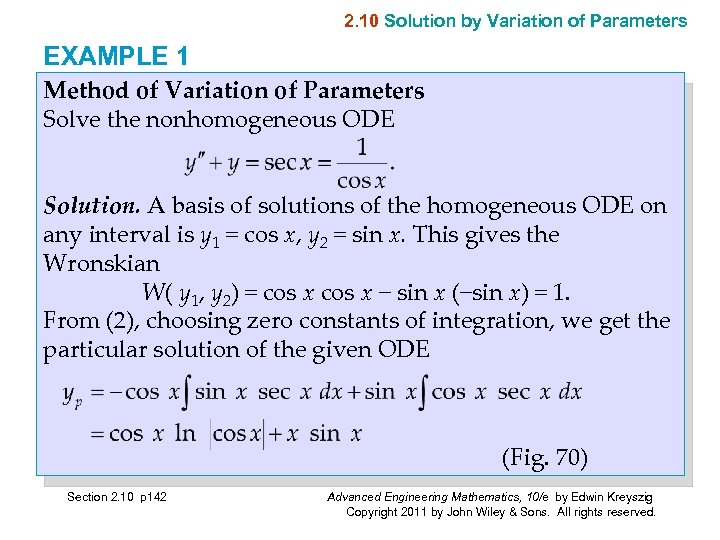 2. 10 Solution by Variation of Parameters EXAMPLE 1 Method of Variation of Parameters Solve the nonhomogeneous ODE Solution. A basis of solutions of the homogeneous ODE on any interval is y 1 = cos x, y 2 = sin x. This gives the Wronskian W( y 1, y 2) = cos x − sin x (−sin x) = 1. From (2), choosing zero constants of integration, we get the particular solution of the given ODE (Fig. 70) Section 2. 10 p 142 Advanced Engineering Mathematics, 10/e by Edwin Kreyszig Copyright 2011 by John Wiley & Sons. All rights reserved.
2. 10 Solution by Variation of Parameters EXAMPLE 1 Method of Variation of Parameters Solve the nonhomogeneous ODE Solution. A basis of solutions of the homogeneous ODE on any interval is y 1 = cos x, y 2 = sin x. This gives the Wronskian W( y 1, y 2) = cos x − sin x (−sin x) = 1. From (2), choosing zero constants of integration, we get the particular solution of the given ODE (Fig. 70) Section 2. 10 p 142 Advanced Engineering Mathematics, 10/e by Edwin Kreyszig Copyright 2011 by John Wiley & Sons. All rights reserved.
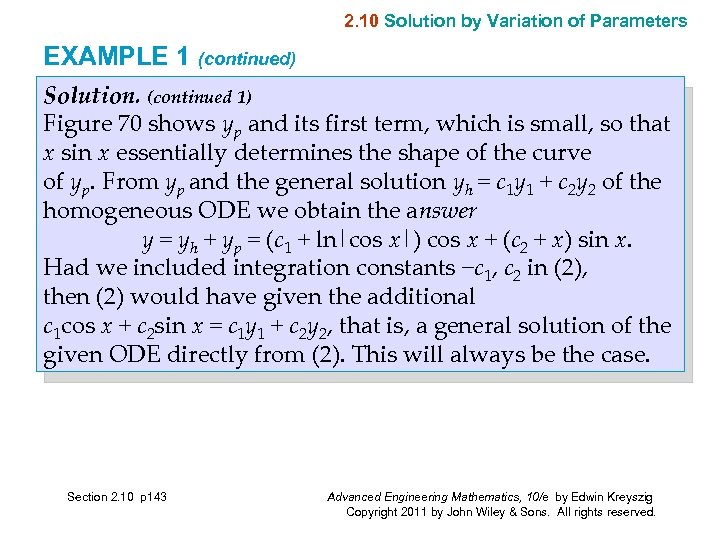 2. 10 Solution by Variation of Parameters EXAMPLE 1 (continued) Solution. (continued 1) Figure 70 shows yp and its first term, which is small, so that x sin x essentially determines the shape of the curve of yp. From yp and the general solution yh = c 1 y 1 + c 2 y 2 of the homogeneous ODE we obtain the answer y = yh + yp = (c 1 + ln|cos x|) cos x + (c 2 + x) sin x. Had we included integration constants −c 1, c 2 in (2), then (2) would have given the additional c 1 cos x + c 2 sin x = c 1 y 1 + c 2 y 2, that is, a general solution of the given ODE directly from (2). This will always be the case. Section 2. 10 p 143 Advanced Engineering Mathematics, 10/e by Edwin Kreyszig Copyright 2011 by John Wiley & Sons. All rights reserved.
2. 10 Solution by Variation of Parameters EXAMPLE 1 (continued) Solution. (continued 1) Figure 70 shows yp and its first term, which is small, so that x sin x essentially determines the shape of the curve of yp. From yp and the general solution yh = c 1 y 1 + c 2 y 2 of the homogeneous ODE we obtain the answer y = yh + yp = (c 1 + ln|cos x|) cos x + (c 2 + x) sin x. Had we included integration constants −c 1, c 2 in (2), then (2) would have given the additional c 1 cos x + c 2 sin x = c 1 y 1 + c 2 y 2, that is, a general solution of the given ODE directly from (2). This will always be the case. Section 2. 10 p 143 Advanced Engineering Mathematics, 10/e by Edwin Kreyszig Copyright 2011 by John Wiley & Sons. All rights reserved.
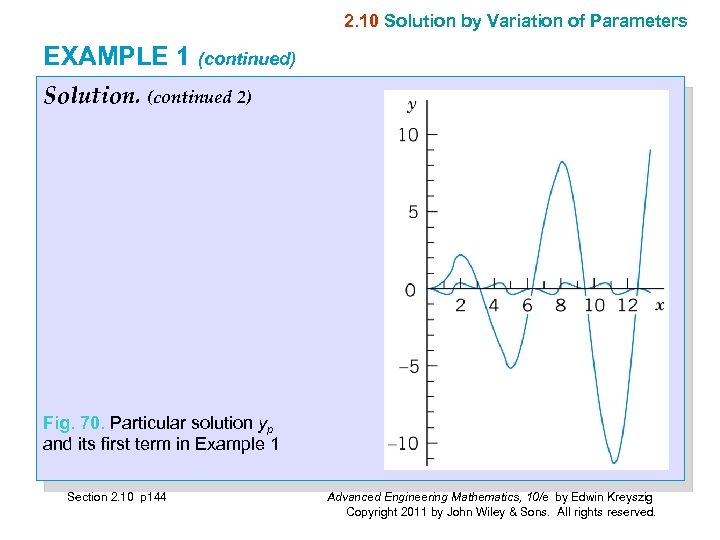 2. 10 Solution by Variation of Parameters EXAMPLE 1 (continued) Solution. (continued 2) Fig. 70. Particular solution yp and its first term in Example 1 Section 2. 10 p 144 Advanced Engineering Mathematics, 10/e by Edwin Kreyszig Copyright 2011 by John Wiley & Sons. All rights reserved.
2. 10 Solution by Variation of Parameters EXAMPLE 1 (continued) Solution. (continued 2) Fig. 70. Particular solution yp and its first term in Example 1 Section 2. 10 p 144 Advanced Engineering Mathematics, 10/e by Edwin Kreyszig Copyright 2011 by John Wiley & Sons. All rights reserved.
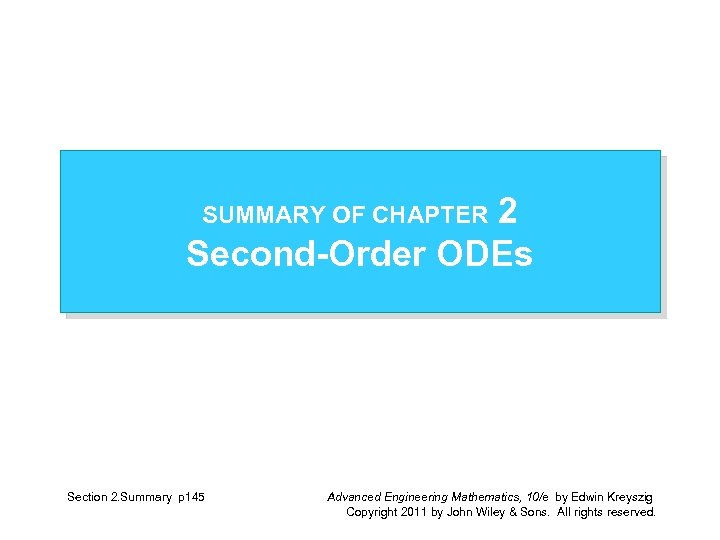 2 Second-Order ODEs SUMMARY OF CHAPTER Section 2. Summary p 145 Advanced Engineering Mathematics, 10/e by Edwin Kreyszig Copyright 2011 by John Wiley & Sons. All rights reserved.
2 Second-Order ODEs SUMMARY OF CHAPTER Section 2. Summary p 145 Advanced Engineering Mathematics, 10/e by Edwin Kreyszig Copyright 2011 by John Wiley & Sons. All rights reserved.
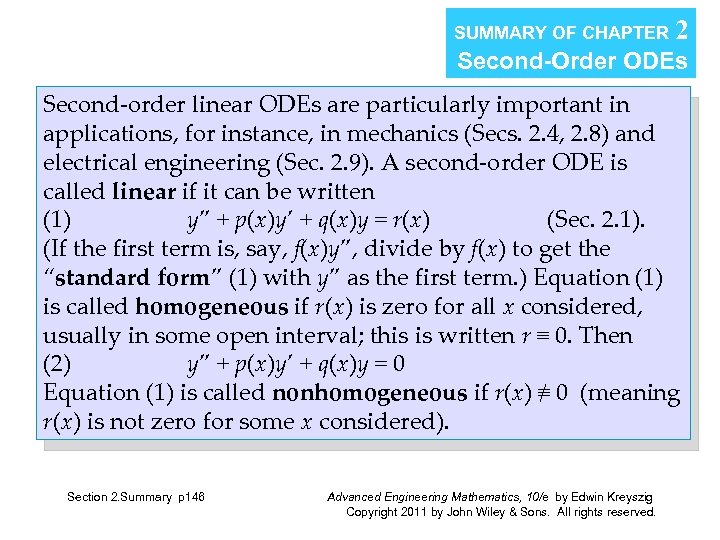 SUMMARY OF CHAPTER 2 Second-Order ODEs Second-order linear ODEs are particularly important in applications, for instance, in mechanics (Secs. 2. 4, 2. 8) and electrical engineering (Sec. 2. 9). A second-order ODE is called linear if it can be written (1) y” + p(x)y’ + q(x)y = r(x) (Sec. 2. 1). (If the first term is, say, f(x)y”, divide by f(x) to get the “standard form” (1) with y” as the first term. ) Equation (1) is called homogeneous if r(x) is zero for all x considered, usually in some open interval; this is written r ≡ 0. Then (2) y” + p(x)y’ + q(x)y = 0 Equation (1) is called nonhomogeneous if r(x) ≡ 0 (meaning r(x) is not zero for some x considered). Section 2. Summary p 146 Advanced Engineering Mathematics, 10/e by Edwin Kreyszig Copyright 2011 by John Wiley & Sons. All rights reserved.
SUMMARY OF CHAPTER 2 Second-Order ODEs Second-order linear ODEs are particularly important in applications, for instance, in mechanics (Secs. 2. 4, 2. 8) and electrical engineering (Sec. 2. 9). A second-order ODE is called linear if it can be written (1) y” + p(x)y’ + q(x)y = r(x) (Sec. 2. 1). (If the first term is, say, f(x)y”, divide by f(x) to get the “standard form” (1) with y” as the first term. ) Equation (1) is called homogeneous if r(x) is zero for all x considered, usually in some open interval; this is written r ≡ 0. Then (2) y” + p(x)y’ + q(x)y = 0 Equation (1) is called nonhomogeneous if r(x) ≡ 0 (meaning r(x) is not zero for some x considered). Section 2. Summary p 146 Advanced Engineering Mathematics, 10/e by Edwin Kreyszig Copyright 2011 by John Wiley & Sons. All rights reserved.
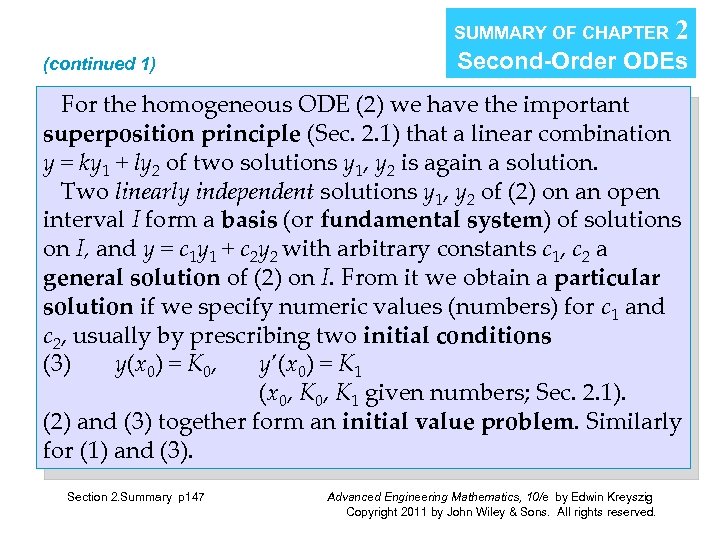 SUMMARY OF CHAPTER (continued 1) 2 Second-Order ODEs For the homogeneous ODE (2) we have the important superposition principle (Sec. 2. 1) that a linear combination y = ky 1 + ly 2 of two solutions y 1, y 2 is again a solution. Two linearly independent solutions y 1, y 2 of (2) on an open interval I form a basis (or fundamental system) of solutions on I, and y = c 1 y 1 + c 2 y 2 with arbitrary constants c 1, c 2 a general solution of (2) on I. From it we obtain a particular solution if we specify numeric values (numbers) for c 1 and c 2, usually by prescribing two initial conditions (3) y(x 0) = K 0, y’(x 0) = K 1 (x 0, K 1 given numbers; Sec. 2. 1). (2) and (3) together form an initial value problem. Similarly for (1) and (3). Section 2. Summary p 147 Advanced Engineering Mathematics, 10/e by Edwin Kreyszig Copyright 2011 by John Wiley & Sons. All rights reserved.
SUMMARY OF CHAPTER (continued 1) 2 Second-Order ODEs For the homogeneous ODE (2) we have the important superposition principle (Sec. 2. 1) that a linear combination y = ky 1 + ly 2 of two solutions y 1, y 2 is again a solution. Two linearly independent solutions y 1, y 2 of (2) on an open interval I form a basis (or fundamental system) of solutions on I, and y = c 1 y 1 + c 2 y 2 with arbitrary constants c 1, c 2 a general solution of (2) on I. From it we obtain a particular solution if we specify numeric values (numbers) for c 1 and c 2, usually by prescribing two initial conditions (3) y(x 0) = K 0, y’(x 0) = K 1 (x 0, K 1 given numbers; Sec. 2. 1). (2) and (3) together form an initial value problem. Similarly for (1) and (3). Section 2. Summary p 147 Advanced Engineering Mathematics, 10/e by Edwin Kreyszig Copyright 2011 by John Wiley & Sons. All rights reserved.
 SUMMARY OF CHAPTER (continued 2) 2 Second-Order ODEs For a nonhomogeneous ODE (1) a general solution is of the form (4) y = yh + yp (Sec. 2. 7). Here yh is a general solution of (2) and yp is a particular solution of (1). Such a yp can be determined by a general method (variation of parameters, Sec. 2. 10) or in many practical cases by the method of undetermined coefficients. The latter applies when (1) has constant coefficients p and q, and r(x) is a power of x, sine, cosine, etc. (Sec. 2. 7). Then we write (1) as (5) y” + ay’ + by = r(x) (Sec. 2. 7). The corresponding homogeneous ODE y’ + ay’ + by = 0 has solutions y = eλx where λ is a root of (6) λ 2 + aλ + b = 0. Section 2. Summary p 148 Advanced Engineering Mathematics, 10/e by Edwin Kreyszig Copyright 2011 by John Wiley & Sons. All rights reserved.
SUMMARY OF CHAPTER (continued 2) 2 Second-Order ODEs For a nonhomogeneous ODE (1) a general solution is of the form (4) y = yh + yp (Sec. 2. 7). Here yh is a general solution of (2) and yp is a particular solution of (1). Such a yp can be determined by a general method (variation of parameters, Sec. 2. 10) or in many practical cases by the method of undetermined coefficients. The latter applies when (1) has constant coefficients p and q, and r(x) is a power of x, sine, cosine, etc. (Sec. 2. 7). Then we write (1) as (5) y” + ay’ + by = r(x) (Sec. 2. 7). The corresponding homogeneous ODE y’ + ay’ + by = 0 has solutions y = eλx where λ is a root of (6) λ 2 + aλ + b = 0. Section 2. Summary p 148 Advanced Engineering Mathematics, 10/e by Edwin Kreyszig Copyright 2011 by John Wiley & Sons. All rights reserved.
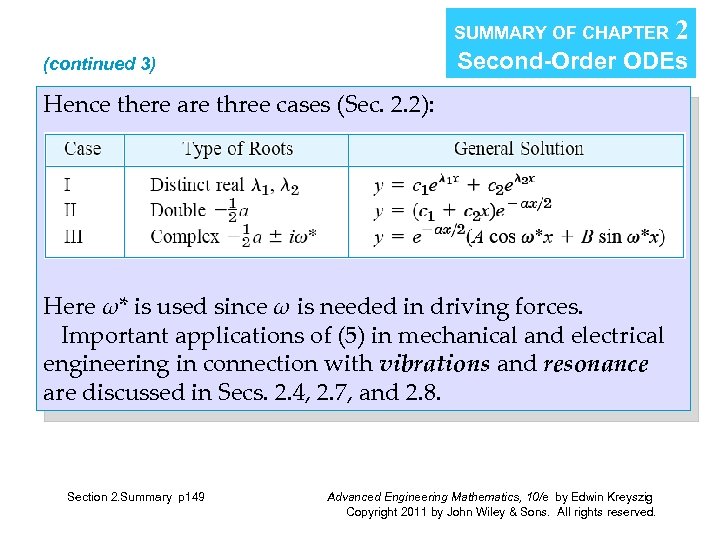 SUMMARY OF CHAPTER Second-Order ODEs (continued 3) Hence there are three cases (Sec. 2. 2): Here ω* is used since ω is needed in driving forces. Important applications of (5) in mechanical and electrical engineering in connection with vibrations and resonance are discussed in Secs. 2. 4, 2. 7, and 2. 8. Section 2. Summary p 149 2 Advanced Engineering Mathematics, 10/e by Edwin Kreyszig Copyright 2011 by John Wiley & Sons. All rights reserved.
SUMMARY OF CHAPTER Second-Order ODEs (continued 3) Hence there are three cases (Sec. 2. 2): Here ω* is used since ω is needed in driving forces. Important applications of (5) in mechanical and electrical engineering in connection with vibrations and resonance are discussed in Secs. 2. 4, 2. 7, and 2. 8. Section 2. Summary p 149 2 Advanced Engineering Mathematics, 10/e by Edwin Kreyszig Copyright 2011 by John Wiley & Sons. All rights reserved.
 SUMMARY OF CHAPTER (continued 4) Second-Order ODEs Another large class of ODEs solvable “algebraically” consists of the Euler–Cauchy equations (7) x 2 y” + axy’ + by = 0 (Sec. 2. 5). These have solutions of the form y = xm, where m is a solution of the auxiliary equation (8) m 2 + (a − 1)m + b = 0. Existence and uniqueness of solutions of (1) and (2) is discussed in Secs. 2. 6 and 2. 7, and reduction of order in Sec. 2. 1. Section 2. Summary p 150 2 Advanced Engineering Mathematics, 10/e by Edwin Kreyszig Copyright 2011 by John Wiley & Sons. All rights reserved.
SUMMARY OF CHAPTER (continued 4) Second-Order ODEs Another large class of ODEs solvable “algebraically” consists of the Euler–Cauchy equations (7) x 2 y” + axy’ + by = 0 (Sec. 2. 5). These have solutions of the form y = xm, where m is a solution of the auxiliary equation (8) m 2 + (a − 1)m + b = 0. Existence and uniqueness of solutions of (1) and (2) is discussed in Secs. 2. 6 and 2. 7, and reduction of order in Sec. 2. 1. Section 2. Summary p 150 2 Advanced Engineering Mathematics, 10/e by Edwin Kreyszig Copyright 2011 by John Wiley & Sons. All rights reserved.


